Norvège – Wikipedia

Pays d'Europe du Nord
|
Royaume de norvège |
|
|---|---|
  |
|
|
Devise:
Enchant og tro inntil Dovre faller (Bokmål) Einige og tru inntil Dovre est tombé (Nynorsk) "Unis et loyaux jusqu'à la chute de Dovre" |
|
 Montrer la carte de l'Europe
Localisation du royaume de Norvège
en Europe (vert et gris foncé) |
|
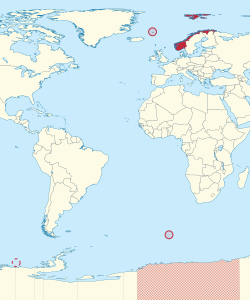 |
|
| Capitale
et la plus grande ville |
Oslo 59 ° 56′N 10 ° 41′E/59,933 ° N 10,683 ° E |
| Langues officielles | |
| Langues minoritaires officielles | |
| Système d'écriture | Latin |
| Groupes ethniques |
Statut autochtone: Statut de minorité:[4] |
| Demonym (s) | norvégien |
| Gouvernement | Monarchie constitutionnelle parlementaire unitaire |
| Harald V | |
| Erna Solberg | |
| Tone W. Trøen | |
| Toril Marie Øie | |
| Conservateur | |
| Corps législatif | Stortinget L Sámediggi |
| L'histoire | |
| 872 | |
| 1263 | |
| 1397 | |
| 1524 | |
| 25 février 1814 | |
| 17 mai 1814 | |
| 4 novembre 1814 | |
| 7 juin 1905 | |
| Surface | |
|
• Total |
385 207 km2 (148 729 milles carrés)[6] (67èmeune) |
|
• Eau (%) |
5.7b |
| Population | |
|
• estimation 2019 |
|
|
• Densité |
13,8 / km2 (35,7 / sq mi) (213e) |
| PIB (PPP) | Estimation 2018 |
|
• Total |
397 milliards de dollars[8] (46ème) |
|
• par habitant |
74 065 $[8] (4ème) |
| PIB (nominal) | Estimation 2018 |
|
• Total |
443 milliards de dollars[8] (22ème) |
|
• par habitant |
82 711 $[8] (3ème) |
| Gini (2017) | faible · 1er |
| HDI (2017) | très haut · 1er |
| Devise | Couronne norvégienne (NOK) |
| Fuseau horaire | UTC + 1 (CET) |
| UTC + 2 (CEST) | |
| Format de date | jj.mm.aaaa |
| Côté conduite | droite |
| Code d'appel | +47 |
| Code ISO 3166 | NON |
| TLD Internet | .nonc |
|
|
Norvège (Norvégien: ![]() Norge (Bokmål) ou
Norge (Bokmål) ou ![]() Noreg (Nynorsk); Sami du Nord: Norga; Sami du Sud: Nöörje; Lule Sami: Vuodna), officiellement le Royaume de norvège, est un pays nordique d’Europe du Nord dont le territoire comprend la partie occidentale et la plus septentrionale de la péninsule scandinave; l'île isolée de Jan Mayen et l'archipel de Svalbard font également partie du Royaume de Norvège.[note 1] L’île Antarctique Peter I et l’île sub-antarctique Bouvet sont des territoires dépendants et ne font donc pas partie du royaume. La Norvège revendique également une partie de l'Antarctique appelée Terre de la Reine Maud.
Noreg (Nynorsk); Sami du Nord: Norga; Sami du Sud: Nöörje; Lule Sami: Vuodna), officiellement le Royaume de norvège, est un pays nordique d’Europe du Nord dont le territoire comprend la partie occidentale et la plus septentrionale de la péninsule scandinave; l'île isolée de Jan Mayen et l'archipel de Svalbard font également partie du Royaume de Norvège.[note 1] L’île Antarctique Peter I et l’île sub-antarctique Bouvet sont des territoires dépendants et ne font donc pas partie du royaume. La Norvège revendique également une partie de l'Antarctique appelée Terre de la Reine Maud.
La Norvège a une superficie totale de 385 207 kilomètres carrés.[6] et une population de 5 312 300 (en août 2018).[12] Le pays partage une longue frontière orientale avec la Suède (1 619 km ou 1 006 mi). La Norvège est bordée au nord-est par la Finlande et la Russie, et au sud par le détroit de Skagerrak, avec le Danemark de l'autre côté. La Norvège a un littoral étendu, faisant face à l'océan Atlantique nord et à la mer de Barents.
Harald V de la maison de Glücksburg est l'actuel roi de Norvège. Erna Solberg est Premier ministre depuis 2013, année où elle a remplacé Jens Stoltenberg. État souverain unitaire doté d'une monarchie constitutionnelle, la Norvège répartit le pouvoir entre le parlement, le cabinet et la cour suprême, conformément à la constitution de 1814. Le royaume a été créé en 872 par la fusion d’un grand nombre de petits royaumes et existe depuis 1147 ans. De 1537 à 1814, la Norvège faisait partie du royaume de Danemark-Norvège et de 1814 à 1905, elle était en union personnelle avec le royaume de Suède. La Norvège était neutre pendant la Première Guerre mondiale. La Norvège est restée neutre jusqu'en avril 1940, date à laquelle le pays a été envahi et occupé par l'Allemagne jusqu'à la fin de la Seconde Guerre mondiale.
La Norvège a des subdivisions administratives et politiques à deux niveaux: les comtés et les municipalités. Le peuple sâme a une certaine autodétermination et influence sur les territoires traditionnels grâce au Parlement sâme et à la loi sur le Finnmark. La Norvège entretient des relations étroites avec l’Union européenne et les États-Unis. La Norvège est un membre fondateur des Nations Unies, de l'OTAN, de l'Association européenne de libre-échange, du Conseil de l'Europe, du Traité sur l'Antarctique et du Conseil nordique. un membre de l'Espace économique européen, de l'OMC et de l'OCDE; et une partie de l'espace Schengen.
La Norvège maintient le modèle de protection sociale nordique avec des soins de santé universels et un système de sécurité sociale complet. Ses valeurs sont enracinées dans des idéaux égalitaires.[13] L’État norvégien détient des participations importantes dans des secteurs industriels clés, disposant de vastes réserves de pétrole, de gaz naturel, de minéraux, de bois d’œuvre, de fruits de mer et d’eau douce. L’industrie pétrolière représente environ un quart du produit intérieur brut (PIB) du pays.[14] Par habitant, la Norvège est le premier producteur mondial de pétrole et de gaz naturel en dehors du Moyen-Orient.[15][16]
Le pays a le quatrième revenu par habitant le plus élevé au monde sur les listes de la Banque mondiale et du FMI.[17] Sur la liste du PIB (PPA) de l'ICA de la CIA (estimation de 2015), qui comprend les territoires et les régions autonomes, la Norvège se classe au onzième rang.[18] Il possède le plus grand fonds souverain du monde, d'une valeur de 1 billion de dollars américains.[19] La Norvège affiche le meilleur indice de développement humain au monde depuis 2009, une position également occupée auparavant entre 2001 et 2006.[20] Il avait également le classement le plus élevé corrigé des inégalités[21][22][23] jusqu'en 2018, date à laquelle l'Islande est passée en haut de la liste.[24] La Norvège au premier rang du World Happiness Report 2017[25] et se classe actuellement au premier rang de l’indice Better Life de l’OCDE, de l’indice d’intégrité publique et de l’indice de la démocratie.[26] La Norvège a l'un des taux de criminalité les plus bas au monde.[27]
Étymologie

La Norvège a deux noms officiels: Norge à Bokmål et Noreg à Nynorsk. Le nom anglais Norway vient du vieux mot anglais Norweg mentionné en 880, signifiant "voie du nord" ou "voie menant au nord", c'est ainsi que les anglo-saxons se référaient au littoral de la Norvège atlantique[28][29] semblable à un consensus scientifique sur l'origine du nom de la langue norvégienne.[30] Les Anglo-Saxons de Grande-Bretagne ont également qualifié le royaume de Norvège en 880 Terre Norðmanna.[28][29]
Il existe un certain désaccord sur le point de savoir si le nom autochtone de Norvège avait à l'origine la même étymologie que la forme anglaise. Selon la vision dominante traditionnelle, le premier composant était à l’origine norðr, un proche de l'anglais Nord, donc le nom complet était Non seulement, "le chemin du nord", faisant référence à la route de navigation le long de la côte norvégienne et contrastant avec suðrvegar "voie méridionale" (du vieux norrois suðr) pour (Allemagne), et austrvegr "voie orientale" (de l'austr) pour la Baltique. Dans la traduction de Orosius pour Alfred, le nom est Norðweg, alors que dans les sources anciennes en anglais ancien, le ð a disparu.[31] Au 10ème siècle, de nombreux nordiques s’établirent dans le nord de la France, d’après les sagas, dans la région appelée plus tard Normandie Norðmann (Norseman ou scandinave[32][33]), mais pas une possession norvégienne.[34] En France Normanni ou Northmanni personnes visées de la Norvège, la Suède ou le Danemark.[35] Jusque vers 1800, les habitants de la Norvège occidentale étaient appelés Nordmenn (habitants du nord), tandis que les habitants de l’est de la Norvège étaient appelés austmenn (hommes de l'est).[36]
Selon une autre théorie, le premier composant était un mot ni, signifiant "étroit" (ancien anglais près de) ou "nord", en référence à la voie de navigation terrestre de l'archipel ("voie étroite"). L'interprétation comme "nordique", comme en témoignent les formes anglaise et latine du nom, aurait alors été due à une étymologie populaire postérieure. Ce dernier point de vue a été créé par le philologue Niels Halvorsen Trønnes en 1847; depuis 2016, il a également été défendu par l'étudiant en langues et militant Klaus Johan Myrvoll et a été adopté par le professeur de philologie Michael Schulte.[28][29] La forme Nore est encore utilisé dans des noms de lieux tels que le village de Nore et le lac Norefjorden dans le comté de Buskerud, et a toujours la même signification.[28][29] Parmi les autres arguments en faveur de la théorie, il est souligné que le mot a une longue voyelle dans la poésie skaldique et n’est pas attesté par <ð> dans des textes ou des inscriptions nordiques indigènes (les premières attestations runiques sont orthographiées Nuruiak et Nuriki). Cette théorie ressuscitée a été quelque peu rejetée par d'autres spécialistes pour divers motifs, e. g. la présence incontestée de l'élément norðr dans l'ethnonyme norðrmaðr "Norseman, personne norvégienne" (norvégien moderne Nordmann), et l'adjectif Norrǿnn "nord, norrois, norvégien", ainsi que les toutes premières attestations des formes latines et anglo-saxonnes avec
Dans un manuscrit latin de 849, le nom Northuagia est mentionné, alors qu'une chronique française de c. 900 utilise les noms Northwegia et Norvège.[37] Quand Ohthere de Hålogaland a rendu visite au roi Alfred le Grand en Angleterre à la fin du neuvième siècle, le pays s'appelait Norðwegr (littéralement "Northway") et Norðmanna Land (littéralement "terre des hommes du nord").[37] Selon Ohthere, Norðmanna vivaient le long de la côte atlantique, les Danois autour de Skagerrak og Kattegat, tandis que les Sames (les "Fins") avaient un style de vie nomade dans le vaste intérieur.[38][39] Ohthere a dit à Alfred qu'il était "le plus septentrional de tous les Norvégiens", probablement sur l'île de Senja ou plus près de Tromsø. Il a également déclaré qu'au-delà des vastes étendues sauvages du sud de la Norvège, se trouvait le pays des Suédois, "Svealand".[40][41]
L'adjectif norvégien, enregistré de c. 1600, est dérivé de la latinisation du nom en tant que Norvège; dans l'adjectif norvégien, le vieil anglais orthographe '-weg' a survécu.[42]
Après que la Norvège soit devenue chrétienne, Noregr et Noregi sont devenues les formes les plus courantes, mais au cours du 15ème siècle, les nouvelles formes Noreg (h) et Norg (h) e, retrouvés dans des manuscrits islandais médiévaux, ont pris le relais et ont survécu jusqu'à nos jours.[[citation requise]
L'histoire
Préhistoire
Les premiers habitants furent la culture d'Ahrensburg (du 11ème au 10ème millénaire avant notre ère), une culture du Paléolithique supérieur tardif du Dryas plus jeune, la dernière période de froid à la fin de la glaciation de Weichselian. La culture tire son nom du village d'Ahrensburg, situé à 25 km au nord-est de Hambourg, dans l'État allemand du Schleswig-Holstein, où des fûts de flèche et des massues en bois ont été mis à jour.[43] Les traces les plus anciennes d’occupation humaine en Norvège se trouvent le long de la côte, où l’immense plateau de glace de la dernière période glaciaire a fondu pour la première fois entre 11 000 et 8 000 ans av. Les plus anciennes découvertes sont des outils de pierre datant de 9 500 à 6 000 ans avant JC, découverts dans le Finnmark (culture de la Komsa) au nord et dans le Rogaland (culture de Fosna) au sud-ouest. Cependant, les théories sur deux cultures totalement différentes (la culture Komsa au nord du cercle polaire arctique et la culture Fosna de Trøndelag à Oslofjord étant l'autre) ont été rendues obsolètes dans les années 1970.
Des découvertes plus récentes le long de toute la côte ont révélé aux archéologues que la différence entre les deux pouvait tout simplement être attribuée à différents types d'outils et non à des cultures différentes. La faune côtière constituait un moyen de subsistance pour les pêcheurs et les chasseurs, qui auraient pu se frayer un chemin le long de la côte sud vers 10 000 ans avant notre ère, alors que l'intérieur était encore recouvert de glace. On pense maintenant que ces peuples dits "arctiques" sont venus du sud et ont suivi la côte vers le nord beaucoup plus tard.
Dans la partie méridionale du pays, des sites d'habitation datant d'environ 5 000 ans av. Les découvertes de ces sites donnent une idée plus précise de la vie des peuples chasseurs et pêcheurs. Les outils varient en forme et sont principalement constitués de différents types de pierre; ceux des périodes ultérieures sont plus habiles. Des gravures rupestres (pétroglyphes, par exemple) ont été découvertes, généralement près des terrains de chasse et de pêche. Ils représentent des gibiers comme le cerf, le renne, le wapiti, les ours, les oiseaux, les phoques, les baleines et les poissons (en particulier le saumon et le flétan), qui étaient tous essentiels au mode de vie des populations côtières. Les gravures rupestres d'Alta dans le Finnmark, les plus grandes de Scandinavie, ont été réalisées au niveau de la mer de 4 200 à 500 av. J.-C. et marquent la progression de la terre à mesure que la mer montait après la fin de la dernière glaciation.
L'Âge de bronze
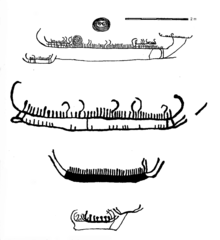
Entre 3000 et 2500 avant JC, de nouveaux colons (culture Corded Ware) sont arrivés dans l'est de la Norvège. C'étaient des agriculteurs indo-européens qui cultivaient des céréales et élevaient des vaches et des moutons. La population de chasseurs-pêcheurs de la côte ouest a également été progressivement remplacée par des agriculteurs, bien que la chasse et la pêche restent des moyens de subsistance secondaires utiles.
Vers 1500 av. J.-C., le bronze fut introduit progressivement, mais l'utilisation d'instruments de pierre continua. La Norvège avait peu de richesses à échanger contre des objets en bronze et les quelques trouvailles consistent principalement en armes sophistiquées et en broches que seuls les chefs pouvaient se permettre. D'énormes cairns funéraires construits près de la mer aussi au nord que Harstad et aussi à l'intérieur des terres au sud sont caractéristiques de cette période. Les motifs des gravures rupestres diffèrent de ceux typiques de l'âge de pierre. Les représentations du soleil, des animaux, des arbres, des armes, des navires et des personnages sont fortement stylisées.
Des milliers de gravures rupestres datant de cette période représentent des navires, et les grands monuments funéraires en pierre connus sous le nom de navires en pierre suggèrent que les navires et la navigation ont joué un rôle important dans la culture en général. Les navires représentés représentent très probablement des canoës construits en planches cousues, utilisés pour la guerre, la pêche et le commerce. Ces types de navires peuvent avoir leur origine dès la période néolithique et continuer jusqu’à l’âge du fer pré-romain, comme l’illustre le bateau Hjortspring.[44]
L'âge de fer
Peu de choses remontent au début de l'âge du fer (500 ans av. J.-C.). Les morts ont été incinérés et leurs tombes contiennent peu d'objets funéraires. Au cours des quatre premiers siècles de notre ère, le peuple norvégien était en contact avec la Gaule occupée par les Romains. Environ 70 chaudrons de bronze romains, souvent utilisés comme urnes funéraires, ont été retrouvés. Le contact avec les pays civilisés plus au sud a apporté une connaissance des runes; la plus ancienne inscription runique norvégienne connue date du 3ème siècle. A cette époque, le nombre de zones habitées dans le pays a augmenté, une évolution qui peut être suivie par des études coordonnées sur la topographie, l'archéologie et les noms de lieux. Les noms de racine les plus anciens, tels que nda, vik et bø ("cape", "baie" et "ferme") sont d'une grande antiquité, datant peut-être de l'âge du bronze, alors que le plus ancien des groupes de noms composés avec les suffixes vin ("prairie") ou heim ("colonie"), comme dans Bjǫrgvin (Bergen) ou Sǿheim (Seim), datent généralement du 1er siècle de notre ère.
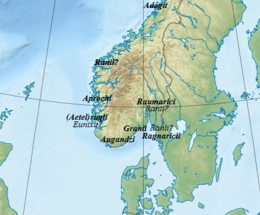
Les archéologues ont d’abord pris la décision de diviser l’âge du fer de l’Europe du Nord en deux âges pré-romain et romain après la découverte par Emil Vedel de nombreux objets datant de l’âge du fer en 1866 sur l’île de Bornholm.[45] Ils n’ont pas exercé la même influence romaine que sur la plupart des autres artefacts des premiers siècles de notre ère, ce qui indique que certaines régions de l’Europe du Nord n’étaient pas encore entrées en contact avec les Romains au début de l’âge du fer.
Période de migration
La destruction de l'Empire romain d'Occident par les peuples germaniques au Ve siècle est caractérisée par de riches découvertes, notamment des tombes de chefs de tribus contenant de magnifiques armes et des objets en or.[[citation requise] Les forts des collines ont été construits sur des rochers escarpés pour se défendre. Les fouilles ont révélé des fondations en pierre de fermes de 18 à 27 mètres de long, voire de 46 mètres de long, dont les toits étaient soutenus par des poteaux en bois. Ces maisons étaient des fermes familiales où plusieurs générations vivaient ensemble, avec des gens et du bétail sous un même toit.[[citation requise]
Ces États étaient basés sur des clans ou des tribus (par exemple, le Horder of Hordaland dans l’ouest de la Norvège). Au IXe siècle, chacun de ces petits États avait des choses (assemblées locales ou régionales) pour la négociation et le règlement des litiges. le chose Les lieux de rencontre, chacun avec éventuellement un hörgr (sanctuaire à ciel ouvert) ou un païen hof (temple; littéralement "colline"), étaient généralement situés dans les fermes les plus anciennes et les meilleures, qui appartenaient aux chefs et aux agriculteurs les plus riches. Le régional des choses réunis pour former des unités encore plus grandes: assemblées de députés de plusieurs régions. De cette façon, le en retard (assemblées de négociation et de législation) développées. Le Gulant avait son lieu de rendez-vous près du Sognefjord et aurait pu être le centre d'une confédération aristocratique[[citation requise] le long des fjords et des îles occidentales appelés Gulatingslag. La Frostating était l’assemblée des dirigeants de la région de Trondheimsfjord; les comtes de Lade, près de Trondheim, semblent avoir élargi le Frostatingslag en ajoutant le littoral de Romsdalsfjord à Lofoten.[[citation requise]
Âge viking
Du 8ème au 10ème siècle, la région scandinave au sens large a été la source des Vikings. Le pillage du monastère de Lindisfarne dans le nord-est de l'Angleterre en 793 par des Nordiques a longtemps été considéré comme l'événement qui a marqué le début de l'âge viking.[46] Cet âge était caractérisé par l’expansion et l’émigration des marins vikings. Ils ont colonisé, perquisitionné et échangé dans toutes les régions d'Europe. Les explorateurs viking norvégiens ont découvert l'Islande par accident au IXe siècle, alors qu'ils se dirigeaient vers les îles Féroé, avant de rencontrer Vinland, aujourd'hui connu sous le nom de Terre-Neuve, au Canada. Les Vikings de Norvège étaient les plus actifs dans le nord et l'ouest des îles Britanniques et dans l'est des îles d'Amérique du Nord.[47]
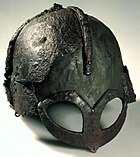
Selon la tradition, Harald Fairhair les a unifiés en 872 après la bataille de Hafrsfjord à Stavanger, devenant ainsi le premier roi d'une Norvège unie.[48] Le royaume de Harald était principalement un État côtier du sud de la Norvège. Fairhair a gouverné avec une main forte et selon les sagas, de nombreux Norvégiens ont quitté le pays pour vivre en Islande, dans les îles Féroé, au Groenland et dans certaines parties de la Grande-Bretagne et de l'Irlande. Les villes irlandaises modernes telles que Dublin, Limerick et Waterford ont été fondées par des colons norvégiens.[49]
Les traditions nordiques ont été remplacées lentement par celles chrétiennes à la fin du 10ème et au début du 11ème siècle. Le traité conclu entre les Islandais et Olaf Haraldsson, roi de Norvège, entre 1015 et 1028, est l’une des sources les plus importantes de l’histoire des Vikings du XIe siècle.[50] Ceci est largement attribué aux rois missionnaires Olav Tryggvasson et St. Olav. Haakon le Bon fut le premier roi chrétien de Norvège au milieu du Xe siècle, bien que sa tentative d'introduire cette religion ait été rejetée. Né entre 963 et 969, Olav Tryggvasson partit en raid en Angleterre avec 390 navires. Il a attaqué Londres pendant ce raid. De retour en Norvège en 995, Olav atterrit à Moster. Là, il construisit une église qui devint la première église chrétienne jamais construite en Norvège. De Moster, Olav a navigué vers le nord à Trondheim où il a été proclamé roi de Norvège par les Eyrathing en 995.[51]
Le féodalisme ne s'est jamais vraiment développé en Norvège ou en Suède, comme dans le reste de l'Europe. Cependant, l'administration du gouvernement prit un caractère féodal très conservateur. La Ligue hanséatique a obligé la royauté à leur céder de plus en plus de concessions sur le commerce extérieur et l'économie. La Ligue avait cette emprise sur la royauté à cause des emprunts que la Hansa avait consentis à la royauté et de la lourde dette des rois. Le contrôle monopolistique de la Ligue sur l’économie de la Norvège a exercé des pressions sur toutes les classes, en particulier la paysannerie, au point qu’il n’existait pas de véritable classe bourgeoise en Norvège.[52]
Guerre civile et point culminant du pouvoir

Des années 1040 à 1130, le pays était en paix.[53] En 1130, l'ère de la guerre civile a éclaté sur la base de lois de succession peu claires, qui permettaient à tous les fils du roi de gouverner ensemble. Pendant des périodes, il pouvait y avoir de la paix avant qu'un fils de moindre rang ne s'allie avec un chef et engage un nouveau conflit. L'archidiocèse de Nidaros a été créé en 1152 et a tenté de contrôler la nomination des rois.[54] L’église devait inévitablement prendre parti dans les conflits, les guerres civiles devenant également un problème concernant l’influence du roi sur l’église. Les guerres ont pris fin en 1217 avec la nomination de Håkon Håkonsson, qui a introduit un droit de succession clair.[55]
De 1 000 à 1 300, la population est passée de 150 000 à 400 000 habitants, ce qui a entraîné à la fois davantage de terres défrichées et le lotissement de fermes. Alors que, à l'époque viking, tous les agriculteurs possédaient leur propre terre, en 1300, soixante-dix pour cent des terres appartenaient au roi, à l'église ou à l'aristocratie. Il s’agissait d’un processus progressif dû au fait que les agriculteurs empruntaient de l’argent en période de crise et ne pouvaient pas rembourser. Cependant, les locataires sont toujours restés des hommes libres et les grandes distances et la propriété souvent dispersée signifiaient qu'ils jouissaient de beaucoup plus de liberté que les serfs continentaux. Au XIIIe siècle, environ 20% du rendement d'un fermier revenait au roi, à l'église et aux propriétaires terriens.[56]
Le 14ème siècle est décrit comme l'âge d'or de la Norvège, avec la paix et l'augmentation des échanges commerciaux, en particulier avec les îles britanniques, bien que l'Allemagne devienne de plus en plus importante vers la fin du siècle. Tout au long du Haut Moyen Âge, le roi a établi la Norvège comme État souverain doté d'une administration centrale et de représentants locaux.[57]
En 1349, la peste noire se propagea en Norvège et avait tué un tiers de la population en un an. Des fléaux ultérieurs ont réduit la population à la moitié du point de départ d’ici à 1400. De nombreuses communautés ont été entièrement exterminées, ce qui a entraîné une abondance de terres, permettant aux agriculteurs de se reconvertir dans l’élevage. La réduction des impôts a affaibli la position du roi,[58] et beaucoup d'aristocrates ont perdu la base de leur surplus, en en réduisant certains à de simples agriculteurs. Les dîmes élevées à l'église la rendirent de plus en plus puissante et l'archevêque devint membre du Conseil d'État.[59]

La Ligue hanséatique prit le contrôle du commerce norvégien au 14ème siècle et créa un centre commercial à Bergen. En 1380, Olaf Haakonsson hérita des trônes norvégien et danois, créant ainsi une union entre les deux pays.[59] En 1397, sous Margaret I, l'Union de Kalmar fut créée entre les trois pays scandinaves. Elle a fait la guerre aux Allemands, ce qui a entraîné un blocus commercial et une taxation plus élevée des produits norvégiens, ce qui a entraîné une rébellion. Cependant, le Conseil d'État norvégien était trop faible pour se retirer de l'union.[60]
Margaret poursuivit une politique centralisatrice qui favorisa inévitablement le Danemark, car sa population était supérieure à celle de la Norvège et de la Suède.[61] Margaret a également accordé des privilèges commerciaux aux marchands hanséatiques de Lübeck à Bergen en échange de la reconnaissance de son droit de gouverner, ce qui a porté préjudice à l'économie norvégienne. Les marchands hanséatiques ont formé un État dans un État à Bergen pendant des générations.[62] Les pirates, les "Victual Brothers", ont lancé trois raids dévastateurs sur le port (le dernier en 1427).[63]
La Norvège a glissé de plus en plus au second plan sous la dynastie Oldenburg (créée en 1448). Il y a eu une révolte sous Knut Alvsson en 1502.[64] Les Norvégiens avaient de l'affection pour le roi Christian II, qui résidait dans le pays depuis plusieurs années. La Norvège n'a pas pris part aux événements qui ont conduit à l'indépendance de la Suède du Danemark dans les années 1520.[65]
Union de Kalmar
À la mort de Haakon V (roi de Norvège) en 1319, Magnus Erikson, âgé de trois ans à peine, hérite du trône sous le nom de roi Magnus VII de Norvège. En même temps, un mouvement visant à faire de Magnus le roi de Suède porte ses fruits et les rois de Suède et du Danemark sont élus au trône par leurs nobles respectifs. Ainsi, avec son élection sur le trône de Suède, de Suède et de Norvège ont été unis sous le roi Magnus VII.[66]
En 1349, la peste noire changea radicalement la Norvège, faisant entre 50% et 60% de sa population[67] et le laissant dans une période de déclin social et économique.[68] La peste a laissé la Norvège très pauvre. Bien que le taux de mortalité soit comparable à celui du reste de l'Europe, la reprise économique a pris beaucoup plus de temps en raison de la petite population dispersée.[68] Même avant la peste, la population n'était que d'environ 500 000 personnes.[69] Après la peste, de nombreuses fermes sont restées inactives alors que la population a augmenté lentement.[68] Cependant, les locataires des quelques exploitations agricoles survivantes ont constaté que leurs positions de négociation avec leurs propriétaires se trouvaient considérablement renforcées.[68]

Le roi Magnus VII régna sur la Norvège jusqu'en 1350, date à laquelle son fils, Haakon, fut placé sur le trône sous le nom de Haakon VI.[70] En 1363, Haakon VI épousa Margaret, fille du roi Valdemar IV du Danemark.[68] À la mort de Haakon VI, en 1379, son fils, Olaf IV, n’avait que 10 ans.[68] Olaf avait déjà été élu sur le trône du Danemark le 3 mai 1376.[68] Ainsi, lors de l'accession d'Olaf au trône norvégien, le Danemark et la Norvège sont devenus une union personnelle.[71] La reine Margaret, mère de Olaf et veuve d'Haakon, dirigeait les affaires étrangères du Danemark et de la Norvège pendant la minorité d'Olaf IV.[68]
Margaret travaillait à l’union de la Suède avec le Danemark et la Norvège en faisant élire Olaf au trône suédois. Elle était sur le point d'atteindre cet objectif quand Olaf IV est décédé subitement.[68] Cependant, le Danemark a nommé Margaret gouverneur provisoire à la mort d’Olaf. Le 2 février 1388, la Norvège emboîta le pas et couronna Margaret.[68] La reine Margaret savait que son pouvoir serait plus sûr si elle pouvait trouver un roi pour gouverner à sa place. Elle s'est installée sur Eric de Poméranie, petit-fils de sa soeur. C'est ainsi que lors d'une réunion scandinave à Kalmar, Erik de Poméranie fut couronné roi des trois pays scandinaves. Ainsi, la politique royale a abouti à des unions personnelles entre les pays nordiques, amenant finalement les trônes de la Norvège, du Danemark et de la Suède sous le contrôle de la reine Marguerite lorsque le pays est entré dans l'Union de Kalmar.
Union avec le Danemark
Après la sortie de la Suède de l’Union de Kalmar en 1521, la Norvège essaya de faire de même,[[citation requise] mais la rébellion suivante fut vaincue et la Norvège resta en union avec le Danemark jusqu'en 1814, soit 434 ans au total. Au cours du romantisme national du XIXe siècle, certains ont qualifié cette période de «nuit de 400 ans», puisque tout le pouvoir royal, intellectuel et administratif du royaume était centralisé à Copenhague, au Danemark. En fait, ce fut une période de grande prospérité et de progrès pour la Norvège, notamment en ce qui concerne le transport maritime et le commerce extérieur, et elle assura également la relance du pays après la catastrophe démographique qu'a connue la peste noire. Sur la base des ressources naturelles respectives, Danemark – Norvège constituait en réalité un très bon complément puisque le Danemark répondait aux besoins norvégiens en céréales et en produits alimentaires et que la Norvège fournissait du bois, du métal et du poisson au Danemark.
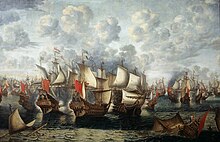
Avec l'introduction du protestantisme en 1536, l'archevêché de Trondheim fut dissout et la Norvège perdit son indépendance et devint effectivement une colonie du Danemark. Les revenus et les biens de l'Église ont plutôt été redirigés vers le tribunal de Copenhague. La Norvège a perdu le flot incessant de pèlerins au profit des reliques de Saint-Olav au sanctuaire de Nidaros, et avec eux une grande partie du contact avec la vie culturelle et économique du reste de l'Europe.
Finalement restauré en tant que royaume (bien qu'en union législative avec le Danemark) en 1661, la Norvège voit son territoire diminuer au 17ème siècle avec la perte des provinces de Båhuslen, Jemtland et Herjedalen en Suède, à la suite d'un certain nombre de guerres désastreuses. avec la Suède. Au nord, toutefois, son territoire a été élargi par l’acquisition des provinces septentrionales de Troms et de Finnmark, aux dépens de la Suède et de la Russie.
La famine de 1695-1696 a tué environ 10% de la population norvégienne.[72] La récolte a échoué en Scandinavie au moins neuf fois entre 1740 et 1800, entraînant de nombreuses pertes de vies humaines.[73]
Union avec la Suède
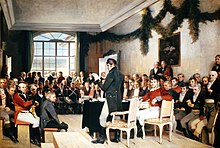
Après l'attaque du Danemark contre la Norvège par le Royaume-Uni lors de la bataille de Copenhague en 1807, le Royaume-Uni conclut une alliance avec Napoléon. La guerre mena à de terribles conditions et provoqua une famine massive en 1812. Le royaume danois se retrouvant du côté des perdants en 1814 Aux termes du traité de Kiel, il fut contraint de céder la Norvège au roi de Suède, tandis que les anciennes provinces norvégiennes d’Islande, du Groenland et des îles Féroé demeuraient sous la couronne danoise.[74] La Norvège saisit cette occasion pour déclarer son indépendance, adopta une constitution inspirée des modèles américain et français et élit le roi héritier du Danemark et de la Norvège, Christian Frederick, le 17 mai 1814 au rang de roi. C'est la célèbre fête de Syttende Mai (le 17 mai) célébré par les Norvégiens et les Américains norvégiens. Syttende Mai est aussi appelé Jour de la Constitution norvégienne.
L'opposition norvégienne à la décision des grandes puissances de lier la Norvège à la Suède provoqua l'éclatement de la guerre entre la Suède et la Suède alors que la Suède tentait de maîtriser la Norvège par des moyens militaires. L'armée suédoise n'étant pas assez forte pour vaincre les forces norvégiennes et le trésor de la Norvège n'étant pas assez important pour soutenir une guerre prolongée, les marines britanniques et russes bloquant la côte norvégienne,[75] les belligérants ont été forcés de négocier la Convention de Moss. Selon les termes de la convention, Christian Frederik a abdiqué le trône norvégien et autorisé le Parlement de Norvège à apporter les modifications constitutionnelles nécessaires pour permettre l'union personnelle que la Norvège a été forcée d'accepter. Le 4 novembre 1814, le Parlement (Storting) élit Charles XIII de Suède au rang de roi de Norvège, établissant ainsi l'union avec la Suède.[76] En vertu de cet arrangement, la Norvège a conservé sa constitution libérale et ses propres institutions indépendantes, à l'exception du service extérieur. À la suite de la récession provoquée par les guerres napoléoniennes, le développement économique de la Norvège demeura lent jusqu'au début de la croissance économique vers 1830.[77]
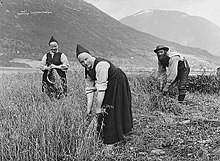
Cette période a également vu la montée du nationalisme romantique norvégien, alors que les Norvégiens cherchaient à définir et à exprimer un caractère national distinct. Le mouvement couvrait toutes les branches de la culture, y compris la littérature (Henrik Wergeland [1808–1845], Bjørnstjerne Bjørnson [1832–1910]Peter Christen Asbjørnsen [1812–1845], Jørgen Moe [1813–1882]), peinture (Hans Gude [1825–1903], Adolph Tidemand [1814–1876]), musique (Edvard Grieg [1843–1907]), et même la politique linguistique, où les tentatives de définition d’une langue maternelle autochtone en Norvège ont abouti aux deux formes écrites officielles en norvégien d’aujourd’hui: le Bokmål et le Nynorsk.
Le roi Charles III Jean, qui accéda au trône de Norvège et de Suède en 1818, fut le deuxième roi après la rupture de la Norvège avec le Danemark et son union avec la Suède. Charles John was a complex man whose long reign extended to 1844. He protected the constitution and liberties of Norway and Sweden during the age of Metternich. As such, he was regarded as a liberal monarch for that age. However, he was ruthless in his use of paid informers, the secret police and restrictions on the freedom of the press to put down public movements for reform—especially the Norwegian national independence movement.[78]
The Romantic Era that followed the reign of King Charles III John brought some significant social and political reforms. In 1854, women won the right to inherit property in their own right, just like men. In 1863, the last trace of keeping unmarried women in the status of minors was removed. Furthermore, women were then eligible for different occupations, particularly the common school teacher.[79] By mid-century, Norway's democracy was limited by modern standards: Voting was limited to officials, property owners, leaseholders and burghers of incorporated towns.[80]

Still, Norway remained a conservative society. Life in Norway (especially economic life) was "dominated by the aristocracy of professional men who filled most of the important posts in the central government".[81] There was no strong bourgeosie class in Norway to demand a breakdown of this aristocratic control of the economy.[82] Thus, even while revolution swept over most of the countries of Europe in 1848, Norway was largely unaffected by revolts that year.[82]

Marcus Thrane was a Utopian socialist. He made his appeal to the labouring classes urging a change of social structure "from below upwards." In 1848, he organised a labour society in Drammen. In just a few months, this society had a membership of 500 and was publishing its own newspaper. Within two years, 300 societies had been organised all over Norway, with a total membership of 20,000 persons. The membership was drawn from the lower classes of both urban and rural areas; for the first time these two groups felt they had a common cause.[83] In the end, the revolt was easily crushed; Thrane was captured and in 1855, after four years in jail, was sentenced to three additional years for crimes against the safety of the state. Upon his release, Marcus Thrane attempted unsuccessfully to revitalise his movement, but after the death of his wife, he migrated to the United States.[84]
In 1898, all men were granted universal suffrage, followed by all women in 1913.
Dissolution of the union
Christian Michelsen, a shipping magnate and statesman, and Prime Minister of Norway from 1905 to 1907, played a central role in the peaceful separation of Norway from Sweden on 7 June 1905. A national referendum confirmed the people's preference for a monarchy over a republic. No Norwegian could legitimately claim the throne because none was able to prove relationship to medieval royalty and in European tradition royal or "blue" blood is a precondition for laying claim to the throne.
The government offered the throne of Norway to a prince of the Dano-German royal house of Schleswig-Holstein-Sonderburg-Glücksburg. Prince Carl of Denmark was unanimously elected king by the Norwegian Parliament, the first king of a fully independent Norway in 508 years (1397: Kalmar Union); he took the name Haakon VII. In 1905, the country welcomed the prince from neighbouring Denmark, his wife Maud of Wales and their young son to re-establish Norway's royal house. Following centuries of close ties between Norway and Denmark, a prince from the latter was the obvious choice for a European prince who could best relate to the Norwegian people.
First and Second World Wars

Throughout the First World War, Norway was in principle a neutral country. In reality, however, Norway had been pressured by the British to hand over increasingly large parts of its large merchant fleet to the British at low rates, as well as to join the trade blockade against Germany. Norwegian merchant marine ships, often with Norwegian sailors still on board, were then sailing under the British flag and at risk of being sunk by German submarines. Thus, many Norwegian sailors and ships were lost. Thereafter, the world ranking of the Norwegian merchant navy fell from fourth place to sixth in the world.[85]
Norway also proclaimed its neutrality during the Second World War, but despite this, it was invaded by German forces on 9 April 1940. Although Norway was unprepared for the German surprise attack (see: Battle of Drøbak Sound, Norwegian Campaign, and Invasion of Norway), military and naval resistance lasted for two months. Norwegian armed forces in the north launched an offensive against the German forces in the Battles of Narvik, until they were forced to surrender on 10 June after losing British support which had been diverted to France during the German invasion of France.

King Haakon and the Norwegian government escaped to Rotherhithe in London. Throughout the war they sent inspirational radio speeches and supported clandestine military actions in Norway against the Germans. On the day of the invasion, the leader of the small National-Socialist party Nasjonal Samling, Vidkun Quisling, tried to seize power, but was forced by the German occupiers to step aside. Real power was wielded by the leader of the German occupation authority, Reichskommissar Josef Terboven. Quisling, as minister president, later formed a collaborationist government under German control. Up to 15,000 Norwegians volunteered to fight in German units, including the Waffen-SS.[86]
The fraction of the Norwegian population that supported Germany was traditionally smaller than in Sweden, but greater than is generally appreciated today.[[citation requise] It included a number of prominent personalities such as the Nobel-prize winning novelist Knut Hamsun. The concept of a "Germanic Union" of member states fit well into their thoroughly nationalist-patriotic ideology.

Many Norwegians and persons of Norwegian descent joined the Allied forces as well as the Free Norwegian Forces. In June 1940, a small group had left Norway following their king to Britain. This group included 13 ships, five aircraft, and 500 men from the Royal Norwegian Navy. By the end of the war, the force had grown to 58 ships and 7,500 men in service in the Royal Norwegian Navy, 5 squadrons of aircraft (including Spitfires, Sunderland flying boats and Mosquitos) in the newly formed Norwegian Air Force, and land forces including the Norwegian Independent Company 1 and 5 Troop as well as No. 10 Commandos.[[citation requise]
During the five years of German occupation, Norwegians built a resistance movement which fought the German occupation forces with both civil disobedience and armed resistance including the destruction of Norsk Hydro's heavy water plant and stockpile of heavy water at Vemork, which crippled the German nuclear programme (see: Norwegian heavy water sabotage). More important to the Allied war effort, however, was the role of the Norwegian Merchant Marine. At the time of the invasion, Norway had the fourth-largest merchant marine fleet in the world. It was led by the Norwegian shipping company Nortraship under the Allies throughout the war and took part in every war operation from the evacuation of Dunkirk to the Normandy landings. Each December Norway gives a Christmas tree to the United Kingdom as thanks for the British assistance during the Second World War. A ceremony takes place to erect the tree in London's Trafalgar Square.[87] Svalbard was not occupied by German troops. Germany secretly established a meteorological station in 1944. The crew was stuck after the general capitulation in May 1945 and were rescued by a Norwegian seal hunter on 4 September. They surrendered to the seal hunter as the last German soldiers to surrender in WW2.[88]
Post-World War II history
From 1945 to 1962, the Labour Party held an absolute majority in the parliament. The government, led by prime minister Einar Gerhardsen, embarked on a program inspired by Keynesian economics, emphasising state financed industrialisation and co-operation between trade unions and employers' organisations. Many measures of state control of the economy imposed during the war were continued, although the rationing of dairy products was lifted in 1949, while price control and rationing of housing and cars continued as long as until 1960.
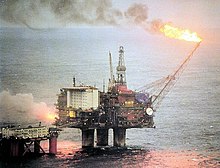
The wartime alliance with the United Kingdom and the United States was continued in the post-war years. Although pursuing the goal of a socialist economy, the Labour Party distanced itself from the Communists (especially after the Communists' seizure of power in Czechoslovakia in 1948), and strengthened its foreign policy and defence policy ties with the US. Norway received Marshall Plan aid from the United States starting in 1947, joined the Organisation for Economic Co-operation and Development (OEEC) one year later, and became a founding member of the North Atlantic Treaty Organization (NATO) in 1949.
The first oil was discovered at the small Balder field in 1967, production only began in 1999.[89] In 1969, the Phillips Petroleum Company discovered petroleum resources at the Ekofisk field west of Norway. In 1973, the Norwegian government founded the State oil company, Statoil. Oil production did not provide net income until the early 1980s because of the large capital investment that was required to establish the country's petroleum industry. Around 1975, both the proportion and absolute number of workers in industry peaked. Since then labour-intensive industries and services like factory mass production and shipping have largely been outsourced.
Norway was a founding member of the European Free Trade Association (EFTA). Norway was twice invited to join the European Union, but ultimately declined to join after referendums that failed by narrow margins in 1972 and 1994.[90]

In 1981, a Conservative government led by Kåre Willoch replaced the Labour Party with a policy of stimulating the stagflated economy with tax cuts, economic liberalisation, deregulation of markets, and measures to curb record-high inflation (13.6% in 1981).
Norway's first female prime minister, Gro Harlem Brundtland of the Labour party, continued many of the reforms of her conservative predecessor, while backing traditional Labour concerns such as social security, high taxes, the industrialisation of nature, and feminism. By the late 1990s, Norway had paid off its foreign debt and had started accumulating a sovereign wealth fund. Since the 1990s, a divisive question in politics has been how much of the income from petroleum production the government should spend, and how much it should save.
In 2011, Norway suffered two terrorist attacks on the same day conducted by Anders Behring Breivik which struck the government quarter in Oslo and a summer camp of the Labour party's youth movement at Utøya island, resulting in 77 deaths and 319 wounded.
The 2013 Norwegian parliamentary election brought a more conservative government to power, with the Conservative Party and the Progress Party winning 43% of the electorate's votes.
La géographie

Norway's core territory comprises the western and northernmost portion of the Scandinavian Peninsula; the remote island of Jan Mayen and the archipelago of Svalbard are also part of the Kingdom of Norway.[note 2] The Antarctic Peter I Island and the sub-Antarctic Bouvet Island are dependent territories and thus not considered part of the Kingdom. Norway also lays claim to a section of Antarctica known as Queen Maud Land.[91] From the Middle Ages to 1814 Norway was part of the Danish kingdom. Norwegian possessions in the North Atlantic, Faroe Islands, Greenland, and Iceland, remained Danish when Norway was passed to Sweden at the Treaty of Kiel.[92] Norway also comprised Bohuslän until 1658, Jämtland and Härjedalen until 1645,[91] Shetland and Orkney until 1468,[93] and the Hebrides and Isle of Man until the Treaty of Perth in 1266.[94]
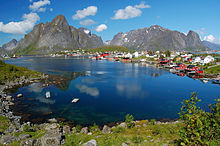
Norway comprises the western and northernmost part of Scandinavia in Northern Europe.[95] Norway lies between latitudes 57° and 81° N, and longitudes 4° and 32° E. Norway is the northernmost of the Nordic countries and if Svalbard is included also the easternmost.[96] Vardø at 31° 10' 07" east of Greenwich lies further east than St. Petersburg and Istanbul.[97] Norway includes the northernmost point on the European mainland.[98] The rugged coastline is broken by huge fjords and thousands of islands. The coastal baseline is 2,532 kilometres (1,573 mi). The coastline of the mainland including fjords stretches 28,953 kilometres (17,991 mi), when islands are included the coastline has been estimated to 100,915 kilometres (62,706 mi).[99] Norway shares a 1,619-kilometre (1,006 mi) land border with Sweden, 727 kilometres (452 mi) with Finland, and 196 kilometres (122 mi) with Russia to the east. To the north, west and south, Norway is bordered by the Barents Sea, the Norwegian Sea, the North Sea, and Skagerrak.[100] The Scandinavian Mountains form much of the border with Sweden.

At 385,207 square kilometres (148,729 sq mi) (including Svalbard and Jan Mayen) (and 323,808 square kilometres (125,023 sq mi) without)[6], much of the country is dominated by mountainous or high terrain, with a great variety of natural features caused by prehistoric glaciers and varied topography. The most noticeable of these are the fjords: deep grooves cut into the land flooded by the sea following the end of the Ice Age. Sognefjorden is the world's second deepest fjord, and the world's longest at 204 kilometres (127 mi). Hornindalsvatnet is the deepest lake in all Europe.[101] Norway has about 400,000 lakes.[102][103] There are registred 239,057 islands.[95] Permafrost can be found all year in the higher mountain areas and in the interior of Finnmark county. Numerous glaciers are found in Norway.
The land is mostly made of hard granite and gneiss rock, but slate, sandstone, and limestone are also common, and the lowest elevations contain marine deposits. Because of the Gulf Stream and prevailing westerlies, Norway experiences higher temperatures and more precipitation than expected at such northern latitudes, especially along the coast. The mainland experiences four distinct seasons, with colder winters and less precipitation inland. The northernmost part has a mostly maritime Subarctic climate, while Svalbard has an Arctic tundra climate.

Because of the large latitudinal range of the country and the varied topography and climate, Norway has a larger number of different habitats than almost any other European country. There are approximately 60,000 species in Norway and adjacent waters (excluding bacteria and virus). The Norwegian Shelf large marine ecosystem is considered highly productive.[104]
Climat
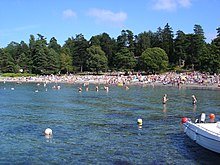
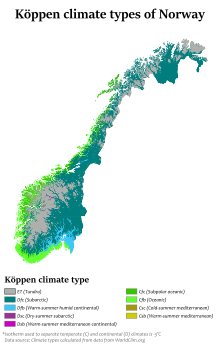
The southern and western parts of Norway, fully exposed to Atlantic storm fronts, experience more precipitation and have milder winters than the eastern and far northern parts. Areas to the east of the coastal mountains are in a rain shadow, and have lower rain and snow totals than the west. The lowlands around Oslo have the warmest and sunniest summers, but also cold weather and snow in wintertime.[107][108]
Because of Norway's high latitude, there are large seasonal variations in daylight. From late May to late July, the sun never completely descends beneath the horizon in areas north of the Arctic Circle (hence Norway's description as the "Land of the Midnight sun"), and the rest of the country experiences up to 20 hours of daylight per day. Conversely, from late November to late January, the sun never rises above the horizon in the north, and daylight hours are very short in the rest of the country.
The coastal climate of Norway is exceptionally mild compared with areas on similar latitudes elsewhere in the world, with the Gulf Stream passing directly offshore the northern areas of the Atlantic coast, continuously warming the region in the winter. Temperature anomalies found in coastal locations are exceptional, with Røst and Værøy lacking a meteorological winter in spite of being north of the Arctic Circle. The Gulf Stream has this effect only on the northern parts of Norway, not in the south, despite what is commonly believed. The northern coast of Norway would thus be ice-covered if not for the Gulf Stream.[109] As a side-effect, the Scandinavian Mountains prevent continental winds from reaching the coastline, causing very cool summers throughout Atlantic Norway. Oslo has more of a continental climate, similar to Sweden's. The mountain ranges have subarctic and tundra climates. There is also very high rainfall in areas exposed to the Atlantic, such as Bergen. Oslo, in comparison, is dry, being in a rain shadow. Skjåk in Oppland county is also in the rain shadow and is one of the driest places with 278 millimetres (10.9 inches) precipitation annually. Finnmarksvidda and the interior valleys of Troms and Nordland also receive less than 300 millimetres (12 inches) annually. Longyearbyen is the driest place in Norway with 190 millimetres (7.5 inches).[110]
Parts of southeastern Norway including parts of Mjøsa have warm-summer humid continental climates (Köppen Dfb), while the more southern and western coasts are mostly of the oceanic climate (Cfb). Further inland in southeastern and northern Norway, the subarctic climate (Dfc) dominates; this is especially true for areas in the rain shadow of the Scandinavian Mountains. Some of the inner valleys of Oppland get so little precipitation annually, thanks to the rain shadow effect, that they meet the requirements for dry-summer subarctic climates (Dsc). In higher altitudes, close to the coasts of southern and western Norway, one can find the rare subpolar oceanic climate (Cfc). This climate is also common in Northern Norway, but there usually in lower altitudes, all the way down to sea level. A small part of the northernmost coast of Norway has the tundra/alpine/polar climate (ET). Large parts of Norway are covered by mountains and high altitude plateaus, many of which also exhibit the tundra/alpine/polar climate (ET).[107][111][112][108][113]
| Climate data for Oslo-Blindern (Köppen Dfb) (1961–1990), Norway | |||||||||||||
|---|---|---|---|---|---|---|---|---|---|---|---|---|---|
| Mois | Jan | fév | Mar | Apr | Peut | Jun | Jul | Aug | Sep | oct | Nov | Dec | Année |
| Record high °C (°F) | 12.5 (54.5) |
12.8 (55.0) |
17.0 (62.6) |
21.8 (71.2) |
27.7 (81.9) |
32.2 (90.0) |
30.5 (86.9) |
34.2 (93.6) |
24.9 (76.8) |
21.0 (69.8) |
14.4 (57.9) |
12.4 (54.3) |
34.2 (93.6) |
| Average high °C (°F) | −1.8 (28.8) |
−0.9 (30.4) |
3,5 (38.3) |
9.1 (48.4) |
15.8 (60.4) |
20.4 (68.7) |
21.5 (70.7) |
20.1 (68.2) |
15.1 (59.2) |
9.3 (48.7) |
3.2 (37.8) |
−0.5 (31.1) |
9.6 (49.2) |
| Daily mean °C (°F) | −4.3 (24.3) |
−4.0 (24.8) |
−0.2 (31.6) |
4,5 (40.1) |
10.8 (51.4) |
15.2 (59.4) |
16.4 (61.5) |
15.2 (59.4) |
10.8 (51.4) |
6.3 (43.3) |
0,7 (33.3) |
−3.1 (26.4) |
5.7 (42.2) |
| Average low °C (°F) | −6.8 (19.8) |
−6.8 (19.8) |
−3.3 (26.1) |
0.8 (33.4) |
6.5 (43.7) |
10.6 (51.1) |
12.2 (54.0) |
11.3 (52.3) |
7.5 (45.5) |
3.8 (38.8) |
−1.5 (29.3) |
−5.6 (21.9) |
2.4 (36.3) |
| Record low °C (°F) | −24.3 (−11.7) |
−24.9 (−12.8) |
−20.2 (−4.4) |
−9.8 (14.4) |
−2.7 (27.1) |
1.4 (34.5) |
5.0 (41.0) |
3.7 (38.7) |
−2 (28) |
−7.4 (18.7) |
−16 (3) |
−20.8 (−5.4) |
−24.9 (−12.8) |
| Average precipitation mm (inches) | 49 (1.9) |
36 (1.4) |
47 (1.9) |
41 (1.6) |
53 (2.1) |
65 (2.6) |
81 (3.2) |
89 (3.5) |
90 (3.5) |
84 (3.3) |
73 (2.9) |
55 (2.2) |
763 (30.1) |
| Average precipitation days | 6 | 4 | 6 | 5 | 5 | 7 | 7 | 8 | 7 | 8 | 8 | 6 | 77 |
| Mean monthly sunshine hours | 40 | 76 | 126 | 178 | 220 | 250 | 246 | 216 | 144 | 86 | 51 | 35 | 1,668 |
| Source #1: Norwegian Meteorological Institute eklima.met.no | |||||||||||||
| Source #2: Met.no[114] (precipitation > 3 mm) | |||||||||||||
| Climate data for Bergen (Köppen Cfb), 1961–1990 | |||||||||||||
|---|---|---|---|---|---|---|---|---|---|---|---|---|---|
| Mois | Jan | fév | Mar | Apr | Peut | Jun | Jul | Aug | Sep | oct | Nov | Dec | Année |
| Record high °C (°F) | 16.9 (62.4) |
13.2 (55.8) |
17.2 (63.0) |
22.5 (72.5) |
27.6 (81.7) |
29.9 (85.8) |
31.8 (89.2) |
31.0 (87.8) |
27.1 (80.8) |
23.1 (73.6) |
17,9 (64.2) |
13.9 (57.0) |
31.8 (89.2) |
| Average high °C (°F) | 4.4 (39.9) |
4.8 (40.6) |
7.1 (44.8) |
11.5 (52.7) |
14.9 (58.8) |
18.0 (64.4) |
20.7 (69.3) |
19.4 (66.9) |
15.9 (60.6) |
12.2 (54.0) |
8.2 (46.8) |
4.9 (40.8) |
11.8 (53.3) |
| Daily mean °C (°F) | 2.2 (36.0) |
2.1 (35.8) |
3.8 (38.8) |
7.4 (45.3) |
10.6 (51.1) |
13.5 (56.3) |
16.4 (61.5) |
15.3 (59.5) |
12.5 (54.5) |
9.1 (48.4) |
5.7 (42.3) |
2,7 (36.9) |
8.4 (47.2) |
| Average low °C (°F) | 0.1 (32.2) |
−0.1 (31.8) |
1.1 (34.0) |
4.0 (39.2) |
6.9 (44.4) |
9.9 (49.8) |
13.2 (55.8) |
12.4 (54.3) |
9.9 (49.8) |
6.5 (43.7) |
3.6 (38.5) |
0.5 (32.9) |
5.7 (42.2) |
| Record low °C (°F) | −16.3 (2.7) |
−13.4 (7.9) |
−11.3 (11.7) |
−0.5 (31.1) |
−0.1 (31.8) |
0.8 (33.4) |
2,5 (36.5) |
2,5 (36.5) |
0.0 (32.0) |
−5.5 (22.1) |
−10 (14) |
−13 (9) |
−16.3 (2.7) |
| Average precipitation mm (inches) | 190 (7.5) |
152 (6.0) |
170 (6.7) |
114 (4.5) |
106 (4.2) |
132 (5.2) |
148 (5.8) |
190 (7.5) |
283 (11.1) |
271 (10.7) |
259 (10.2) |
235 (9.3) |
2,250 (88.7) |
| Average rainy days (≥ 1 mm) | 20 | 15 | 17 | 13 | 14 | 11 | 15 | 17 | 20 | 22 | 17 | 21 | 202 |
| Average relative humidity (%) | 78 | 76 | 73 | 72 | 72 | 76 | 77 | 78 | 79 | 79 | 78 | 79 | 76 |
| Mean monthly sunshine hours | 19 | 56 | 94 | 147 | 186 | 189 | 167 | 144 | 86 | 60 | 27 | 12 | 1,187 |
| Source #1: http://sharki.oslo.dnmi.no/pls/portal/BATCH_ORDER.PORTLET_UTIL.Download_BLob?p_BatchId=666089&p_IntervalId=1351224(eklima.no) (high and low temperatures),[115] NOAA (all else, except extremes)[116] | |||||||||||||
| Source #2: Voodoo Skies for extremes[117] | |||||||||||||
| Climate data for Brønnøysund (Köppen Cfc), 1960–1990 | |||||||||||||
|---|---|---|---|---|---|---|---|---|---|---|---|---|---|
| Mois | Jan | fév | Mar | Apr | Peut | Jun | Jul | Aug | Sep | oct | Nov | Dec | Année |
| Daily mean °C (°F) | −1.1 (30.0) |
−0.6 (30.9) |
0,9 (33.6) |
3.7 (38.7) |
8.4 (47.1) |
11.2 (52.2) |
13.1 (55.6) |
13.0 (55.4) |
9.8 (49.6) |
6.6 (43.9) |
2.2 (36.0) |
−0.1 (31.8) |
5.6 (42.1) |
| Average precipitation mm (inches) | 138 (5.4) |
102 (4.0) |
114 (4.5) |
97 (3.8) |
66 (2.6) |
83 (3.3) |
123 (4.8) |
113 (4.4) |
180 (7.1) |
192 (7.6) |
145 (5.7) |
157 (6.2) |
1,510 (59.4) |
| Source: Meteorologisk Institutt[114] | |||||||||||||
| Climate data for Rena-Haugedalen (Köppen Dfc) (1961–1990), Norway | |||||||||||||
|---|---|---|---|---|---|---|---|---|---|---|---|---|---|
| Mois | Jan | fév | Mar | Apr | Peut | Jun | Jul | Aug | Sep | oct | Nov | Dec | Année |
| Average high °C (°F) | −7.1 (19.2) |
−4.4 (24.1) |
2.4 (36.3) |
7.8 (46.0) |
15.2 (59.4) |
20.2 (68.4) |
20.9 (69.6) |
18.9 (66.0) |
13.3 (55.9) |
6.6 (43.9) |
−1 (30) |
−5.7 (21.7) |
7.3 (45.0) |
| Daily mean °C (°F) | −11.2 (11.8) |
−9.6 (14.7) |
−3.7 (25.3) |
1,7 (35.1) |
8.2 (46.8) |
13.2 (55.8) |
14.4 (57.9) |
12.5 (54.5) |
7.7 (45.9) |
2,9 (37.2) |
−4.3 (24.3) |
−9.3 (15.3) |
1,9 (35.4) |
| Average low °C (°F) | −15.6 (3.9) |
−14.6 (5.7) |
−9.6 (14.7) |
−4 (25) |
1,0 (33.8) |
5.9 (42.6) |
7.6 (45.7) |
6.3 (43.3) |
2,9 (37.2) |
−0.6 (30.9) |
−7.7 (18.1) |
−13.4 (7.9) |
−3.5 (25.7) |
| Average precipitation mm (inches) | 50 (2.0) |
38 (1.5) |
40 (1.6) |
42 (1.7) |
62 (2.4) |
78 (3.1) |
90 (3.5) |
79 (3.1) |
85 (3.3) |
80 (3.1) |
67 (2.6) |
55 (2.2) |
766 (30.1) |
| La source: [118] | |||||||||||||
Biodiversity


The total number of species include 16,000 species of insects (probably 4,000 more species yet to be described), 20,000 species of algae, 1,800 species of lichen, 1,050 species of mosses, 2,800 species of vascular plants, up to 7,000 species of fungi, 450 species of birds (250 species nesting in Norway), 90 species of mammals, 45 fresh-water species of fish, 150 salt-water species of fish, 1,000 species of fresh-water invertebrates, and 3,500 species of salt-water invertebrates.[119] About 40,000 of these species have been described by science. The red list of 2010 encompasses 4,599 species.[120]
Seventeen species are listed mainly because they are endangered on a global scale, such as the European beaver, even if the population in Norway is not seen as endangered. The number of threatened and near-threatened species equals to 3,682; it includes 418 fungi species, many of which are closely associated with the small remaining areas of old-growth forests,[121] 36 bird species, and 16 species of mammals. In 2010, 2,398 species were listed as endangered or vulnerable; of these were 1250 listed as vulnerable (VU), 871 as endangered (EN), and 276 species as critically endangered (CR), among which were the grey wolf, the Arctic fox (healthy population on Svalbard) and the pool frog.[120]
The largest predator in Norwegian waters is the sperm whale, and the largest fish is the basking shark. The largest predator on land is the polar bear, while the brown bear is the largest predator on the Norwegian mainland. The largest land animal on the mainland is the elk (American English: moose). The elk in Norway is known for its size and strength and is often called skogens konge, "king of the forest".
Environnement
Attractive and dramatic scenery and landscape are found throughout Norway.[122] The west coast of southern Norway and the coast of northern Norway present some of the most visually impressive coastal sceneries in the world. National Geographic has listed the Norwegian fjords as the world's top tourist attraction.[123] The country is also home to the natural phenomena of the Midnight sun (during summer), as well as the Aurora borealis known also as the Northern lights.[124]
The 2016 Environmental Performance Index from Yale University, Columbia University and the World Economic Forum put Norway in seventeenth place, immediately below Croatia and Switzerland.[125] The index is based on environmental risks to human health, habitat loss, and changes in CO2 emissions. The index notes over-exploitation of fisheries, but not Norway's whaling or oil exports.[126]
Politics and government

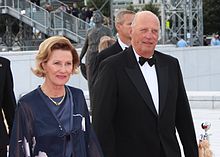


Norway is considered to be one of the most developed democracies and states of justice in the world. From 1814, c. 45% of men (25 years and older) had the right to vote, whereas the United Kingdom had c. 20% (1832), Sweden c. 5% (1866), and Belgium c. 1.15% (1840). Since 2010, Norway has been classified as the world's most democratic country by the Democracy Index.[127][128][129]
According to the Constitution of Norway, which was adopted on 17 May 1814[130] and inspired by the United States Declaration of Independence and French Revolution of 1776 and 1789, respectively, Norway is a unitary constitutional monarchy with a parliamentary system of government, wherein the King of Norway is the head of state and the prime minister is the head of government. Power is separated among the legislative, executive and judicial branches of government, as defined by the Constitution, which serves as the country's supreme legal document.
The monarch officially retains executive power. But following the introduction of a parliamentary system of government, the duties of the monarch have since become strictly representative and ceremonial,[131] such as the formal appointment and dismissal of the Prime Minister and other ministers in the executive government. Accordingly, the Monarch is commander-in-chief of the Norwegian Armed Forces, and serves as chief diplomatic official abroad and as a symbol of unity. Harald V of the House of Schleswig-Holstein-Sonderburg-Glücksburg was crowned King of Norway in 1991, the first since the 14th century who has been born in the country.[132] Haakon, Crown Prince of Norway, is the legal and rightful heir to the throne and the Kingdom.
In practice, the Prime Minister exercises the executive powers. Constitutionally, legislative power is vested with both the government and the Parliament of Norway, but the latter is the supreme legislature and a unicameral body.[133] Norway is fundamentally structured as a representative democracy. The Parliament can pass a law by simple majority of the 169 representatives, who are elected on the basis of proportional representation from 19 constituencies for four-year terms.
150 are elected directly from the 19 constituencies, and an additional 19 seats ("levelling seats") are allocated on a nationwide basis to make the representation in parliament correspond better with the popular vote for the political parties. A 4% election threshold is required for a party to gain levelling seats in Parliament.[134] There are a total of 169 members of parliament.
The Parliament of Norway, called the Stortinget (meaning Grand Assembly), ratifies national treaties developed by the executive branch. It can impeach members of the government if their acts are declared unconstitutional. If an indicted suspect is impeached, Parliament has the power to remove the person from office.
The position of prime minister, Norway's head of government, is allocated to the member of Parliament who can obtain the confidence of a majority in Parliament, usually the current leader of the largest political party or, more effectively, through a coalition of parties. A single party generally does not have sufficient political power in terms of the number of seats to form a government on its own. Norway has often been ruled by minority governments.
The prime minister nominates the cabinet, traditionally drawn from members of the same political party or parties in the Storting, making up the government. The PM organises the executive government and exercises its power as vested by the Constitution.[135] Norway has a state church, the Lutheran Church of Norway, which has in recent years gradually been granted more internal autonomy in day-to-day affairs, but which still has a special constitutional status. Formerly, the PM had to have more than half the members of cabinet be members of the Church of Norway, meaning at least ten out of the 19 ministries. This rule was however removed in 2012. The issue of separation of church and state in Norway has been increasingly controversial, as many people believe it is time to change this, to reflect the growing diversity in the population. A part of this is the evolution of the public school subject Christianity, a required subject since 1739. Even the state's loss in a battle at the European Court of Human Rights at Strasbourg[136] in 2007 did not settle the matter. As of 1 January 2017, the Church of Norway is a separate legal entity, and no longer a branch of the civil service.[137]
Through the Council of State, a privy council presided over by the monarch, the prime minister and the cabinet meet at the Royal Palace and formally consult the Monarch. All government bills need the formal approval by the monarch before and after introduction to Parliament. The Council reviews and approves all of the monarch's actions as head of state. Although all government and parliamentary acts are decided beforehand, the privy council is an example of symbolic gesture the king retains.[132]
Members of the Storting are directly elected from party-lists proportional representation in nineteen plural-member constituencies in a national multi-party system.[138] Historically, both the Norwegian Labour Party and Conservative Party have played leading political roles. In the early 21st century, the Labour Party has been in power since the 2005 election, in a Red–Green Coalition with the Socialist Left Party and the Centre Party.[139]
Since 2005, both the Conservative Party and the Progress Party have won numerous seats in the Parliament, but not sufficient in the 2009 general election to overthrow the coalition. Commentators have pointed to the poor co-operation between the opposition parties, including the Liberals and the Christian Democrats. Jens Stoltenberg, the leader of the Labour Party, continued to have the necessary majority through his multi-party alliance to continue as PM until 2013.[140]
In national elections in September 2013, voters ended eight years of Labor rule. Two political parties, Høyre and Fremskrittspartiet, elected on promises of tax cuts, more spending on infrastructure and education, better services and stricter rules on immigration, formed a government. Coming at a time when Norway's economy is in good condition with low unemployment, the rise of the right appeared to be based on other issues. Erna Solberg became prime minister, the second female prime minister after Brundtland and the first conservative prime minister since Syse. Solberg said her win was "a historic election victory for the right-wing parties".[141]
divisions administratives
Norway, a unitary state, is divided into eighteen first-level administrative counties (fylke). The counties are administrated through directly elected county assemblies who elect the County Governor. Additionally, the King and government are represented in every county by a fylkesmann, who effectively acts as a Governor.[142] As such, the Government is directly represented at a local level through the County Governors' offices. The counties are then sub-divided into 422-second-level municipalities (kommuner), which in turn are administrated by directly elected municipal council, headed by a mayor and a small executive cabinet. The capital of Oslo is considered both a county and a municipality.
Norway has two integral overseas territories: Jan Mayen and Svalbard, the only developed island in the archipelago of the same name, located miles away to the north. There are three Antarctic and Subantarctic dependencies: Bouvet Island, Peter I Island, and Queen Maud Land. On most maps, there had been an unclaimed area between Queen Maud Land and the South Pole until 12 June 2015 when Norway formally annexed that area.[143]

96 settlements have city status in Norway. In most cases, the city borders are coterminous with the borders of their respective municipalities. Often, Norwegian city municipalities include large areas that are not developed; for example, Oslo municipality contains large forests, located north and south-east of the city, and over half of Bergen municipality consists of mountainous areas.

The counties of Norway are:
Largest cities
|
Largest cities or towns in Norway
|
||||||||||||||||
|---|---|---|---|---|---|---|---|---|---|---|---|---|---|---|---|---|
| Rang | prénom | Comté | Pop. | Rang | prénom | Comté | Pop. | |||||||||
 Bergen |
1 | Oslo | Oslo | 1,000,467 | 11 | Moss | Østfold | 46,618 |  Stavanger/Sandnes |
Bergen | Hordaland | 255,464 | 12 | Haugesund | Rogaland | 44,830 |
| 3 | Stavanger/Sandnes | Rogaland | 222,697 | 13 | Sandefjord | Vestfold | 43,595 | |||||||||
| 4 | Trondheim | Trøndelag | 183,378 | 14 | Arendal | Aust-Agder | 43,084 | |||||||||
| 5 | Drammen | Buskerud | 117,510 | 15 | Bodø | Nordland | 40,705 | |||||||||
| 6 | Fredrikstad/Sarpsborg | Østfold | 111,267 | 16 | Tromsø | Troms | 38,980 | |||||||||
| 7 | Porsgrunn/Skien | Telemark | 92,753 | 17 | Hamar | Hedmark | 27,324 | |||||||||
| 8 | Kristiansand | Vest-Agder | 61,536 | 18 | Halden | Østfold | 25,300 | |||||||||
| 9 | Ålesund | Møre og Romsdal | 52,163 | 19 | Larvik | Vestfold | 24,208 | |||||||||
| dix | Tønsberg | Vestfold | 51,571 | 20 | Askøy | Hordaland | 23,194 | |||||||||
Judicial system and law enforcement
Norway uses a civil law system where laws are created and amended in Parliament and the system regulated through the Courts of justice of Norway. It consists of the Supreme Court of 20 permanent judges and a Chief Justice, appellate courts, city and district courts, and conciliation councils.[144] The judiciary is independent of executive and legislative branches. While the Prime Minister nominates Supreme Court Justices for office, their nomination must be approved by Parliament and formally confirmed by the Monarch in the Council of State. Usually, judges attached to regular courts are formally appointed by the Monarch on the advice of the Prime Minister.
The Courts' strict and formal mission is to regulate the Norwegian judicial system, interpret the Constitution, and as such implement the legislation adopted by Parliament. In its judicial reviews, it monitors the legislative and executive branches to ensure that they comply with provisions of enacted legislation.[144]
The law is enforced in Norway by the Norwegian Police Service. It is a Unified National Police Service made up of 27 Police Districts and several specialist agencies, such as Norwegian National Authority for the Investigation and Prosecution of Economic and Environmental Crime, known as Økokrim; and the National Criminal Investigation Service, known as Kripos, each headed by a chief of police. The Police Service is headed by the National Police Directorate, which reports to the Ministry of Justice and the Police. The Police Directorate is headed by a National Police Commissioner. The only exception is the Norwegian Police Security Agency, whose head answers directly to the Ministry of Justice and the Police.
Norway abolished the death penalty for regular criminal acts in 1902. The legislature abolished the death penalty for high treason in war and war-crimes in 1979. Reporters Without Borders, in its 2007 Worldwide Press Freedom Index, ranked Norway at a shared first place (along with Iceland) out of 169 countries.[145]
In general, the legal and institutional framework in Norway is characterised by a high degree of transparency, accountability and integrity, and the perception and the occurrence of corruption are very low.[146] Norway has ratified all relevant international anti-corruption conventions, and its standards of implementation and enforcement of anti-corruption legislation are considered very high by many international anti-corruption working groups such as the OECD Anti-Bribery Working Group. However, there are some isolated cases showing that some municipalities have abused their position in public procurement processes.
Norwegian prisons are humane, rather than tough, with emphasis on rehabilitation. At 20%, Norway's re-conviction rate is among the lowest in the world.[147]
Foreign relations, including with European Union

Norway maintains embassies in 82 countries.[148] 60 countries maintain an embassy in Norway, all of them in the capital, Oslo.
Norway is a founding member of the United Nations (UN), the North Atlantic Treaty Organization (NATO), the Council of Europe and the European Free Trade Association (EFTA). Norway issued applications for accession to the European Union (EU) and its predecessors in 1962, 1967 and 1992, respectively. While Denmark, Sweden and Finland obtained membership, the Norwegian electorate rejected the treaties of accession in referenda in 1972 and 1994.
After the 1994 referendum, Norway maintained its membership in the European Economic Area (EEA), an arrangement granting the country access to the internal market of the Union, on the condition that Norway implements the Union's pieces of legislation which are deemed relevant (of which there were approximately seven thousand by 2010)[149] Successive Norwegian governments have, since 1994, requested participation in parts of the EU's co-operation that go beyond the provisions of the EEA agreement. Non-voting participation by Norway has been granted in, for instance, the Union's Common Security and Defence Policy, the Schengen Agreement, and the European Defence Agency, as well as 19 separate programmes.[150]
Norway participated in the 1990s brokering of the Oslo Accords, an unsuccessful attempt to resolve the Israeli–Palestinian conflict.
Militaire
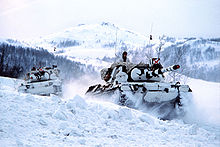
The Norwegian Armed Forces numbers about 25,000 personnel, including civilian employees. According to 2009 mobilisation plans, full mobilisation produces approximately 83,000 combatant personnel. Norway has conscription (including 6–12 months of training);[151] in 2013, the country became the first in Europe and NATO to draft women as well as men. However, due to less need for conscripts after the Cold War ended with the break-up of the Soviet Union, few people have to serve if they are not motivated.[152] The Armed Forces are subordinate to the Norwegian Ministry of Defence. The Commander-in-Chief is King Harald V. The military of Norway is divided into the following branches: the Norwegian Army, the Royal Norwegian Navy, the Royal Norwegian Air Force, the Norwegian Cyber Defence Force and the Home Guard.
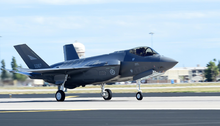
In response to its being overrun by Germany in 1940, the country was one of the founding nations of the North Atlantic Treaty Organization (NATO) on 4 April 1949. At present, Norway contributes in the International Security Assistance Force (ISAF) in Afghanistan.[153] Additionally, Norway has contributed in several missions in contexts of the United Nations, NATO, and the Common Security and Defence Policy of the European Union.
Économie

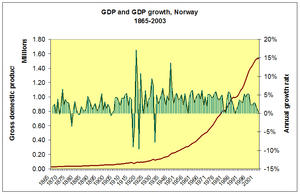
Norwegians enjoy the second-highest GDP per-capita among European countries (after Luxembourg), and the sixth-highest GDP (PPP) per-capita in the world. Today, Norway ranks as the second-wealthiest country in the world in monetary value, with the largest capital reserve per capita of any nation.[154] According to the CIA World Factbook, Norway is a net external creditor of debt.[100] Norway maintained first place in the world in the UNDP Human Development Index (HDI) for six consecutive years (2001–2006),[10] and then reclaimed this position in 2009, through 2015.[21] The standard of living in Norway is among the highest in the world. Foreign Policy magazine ranks Norway last in its Failed States Index for 2009, judging Norway to be the world's most well-functioning and stable country. The OECD ranks Norway fourth in the 2013 equalised Better Life Index and third in intergenerational earnings elasticity.[155][156]
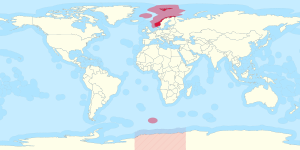
The Norwegian economy is an example of a mixed economy, a prosperous capitalist welfare state and social democracy country featuring a combination of free market activity and large state ownership in certain key sectors. Public health care in Norway is free (after an annual charge of around 2000 kroner for those over 16), and parents have 46 weeks paid[157] parental leave. The state income derived from natural resources includes a significant contribution from petroleum production. Norway has an unemployment rate of 4.8%, with 68% of the population aged 15–74 employed.[158] People in the labour force are either employed or looking for work.[159] 9.5% of the population aged 18–66 receive a disability pension[160] and 30% of the labour force are employed by the government, the highest in the OECD.[161] The hourly productivity levels, as well as average hourly wages in Norway, are among the highest in the world.[162][163]
The egalitarian values of Norwegian society have kept the wage difference between the lowest paid worker and the CEO of most companies as much less than in comparable western economies.[164] This is also evident in Norway's low Gini coefficient.
The state has large ownership positions in key industrial sectors, such as the strategic petroleum sector (Statoil), hydroelectric energy production (Statkraft), aluminium production (Norsk Hydro), the largest Norwegian bank (DNB), and telecommunication provider (Telenor). Through these big companies, the government controls approximately 30% of the stock values at the Oslo Stock Exchange. When non-listed companies are included, the state has even higher share in ownership (mainly from direct oil licence ownership). Norway is a major shipping nation and has the world's 6th largest merchant fleet, with 1,412 Norwegian-owned merchant vessels.
By referendums in 1972 and 1994, Norwegians rejected proposals to join the European Union (EU). However, Norway, together with Iceland and Liechtenstein, participates in the European Union's single market through the European Economic Area (EEA) agreement. The EEA Treaty between the European Union countries and the EFTA countries– transposed into Norwegian law via "EØS-loven"[165]– describes the procedures for implementing European Union rules in Norway and the other EFTA countries. Norway is a highly integrated member of most sectors of the EU internal market. Some sectors, such as agriculture, oil and fish, are not wholly covered by the EEA Treaty. Norway has also acceded to the Schengen Agreement and several other intergovernmental agreements among the EU member states.
The country is richly endowed with natural resources including petroleum, hydropower, fish, forests, and minerals. Large reserves of petroleum and natural gas were discovered in the 1960s, which led to a boom in the economy. Norway has obtained one of the highest standards of living in the world in part by having a large amount of natural resources compared to the size of the population. In 2011, 28% of state revenues were generated from the petroleum industry.[166]
Norway is the first country which banned cutting of trees (deforestation), in order to prevent rain forests from vanishing. The country declared its intention at the UN Climate Summit in 2014, alongside Great Britain and Germany. Crops, that are typically linked to forests' destruction are timber, soy, palm oil and beef. Now Norway has to find a new way to provide these essential products without exerting negative influence on its environment.[167]
Ressources

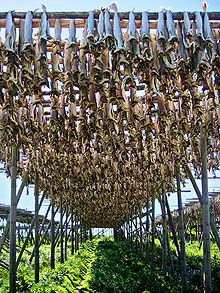
- Oil industry

Export revenues from oil and gas have risen to almost 50% of total exports and constitute more than 20% of the GDP.[168] Norway is the fifth-largest oil exporter and third-largest gas exporter in the world, but it is not a member of OPEC. In 1995, the Norwegian government established the sovereign wealth fund ("Government Pension Fund – Global"), which would be funded with oil revenues, including taxes, dividends, sales revenues and licensing fees. This was intended to reduce overheating in the economy from oil revenues, minimise uncertainty from volatility in oil price, and provide a cushion to compensate for expenses associated with the ageing of the population.
The government controls its petroleum resources through a combination of state ownership in major operators in the oil fields (with approximately 62% ownership in Statoil in 2007) and the fully state-owned Petoro, which has a market value of about twice Statoil, and SDFI. Finally, the government controls licensing of exploration and production of fields. The fund invests in developed financial markets outside Norway. The budgetary rule (Handlingsregelen) is to spend no more than 4% of the fund each year (assumed to be the normal yield from the fund).
- Oil fields
Between 1966 and 2013, Norwegian companies drilled 5085 oil wells, mostly in the North Sea.[169] Of these 3672 are utviklingsbrønner (regular production);[169] 1413 are letebrønner (exploration); and 1405 have been terminated (avsluttet).[169]
Oil fields not yet in production phase include: Wisting Central—calculated size in 2013, 65–156 million barrels of oil and 10 to 40 billion cubic feet (0.28 to 1.13 billion cubic metres), (utvinnbar) of gas.[170] and the Castberg Oil Field (Castberg-feltet[170])—calculated size 540 million barrels of oil, and 2 to 7 billion cubic feet (57 to 198 million cubic metres) (utvinnbar) of gas.[171] Both oil fields are located in the Barents Sea.
- Fish industry
Norway is also the world's second-largest exporter of fish (in value, after China).[172][173] Fish from fish farms and catch constitutes the second largest (behind oil/natural gas) export product measured in value.[174][175]
- Électricité
Hydroelectric plants generate roughly 98–99% of Norway's electric power, more than any other country in the world.[176]
- Mineral resources
Norway contains significant mineral resources, and in 2013, its mineral production was valued at US€1.5 billion (Norwegian Geological Survey data). The most valuable minerals are calcium carbonate (limestone), building stone, nepheline syenite, olivine, iron, titanium, and nickel.[177]
- Norwegian Pension Fund
In March 2017, the Government Pension Fund controlled assets were valued at approximately US€913 billion (equal to US€182,000 per capita), which is about 178% of Norway's current GDP. It is the largest sovereign wealth fund in the world.[178] The fund controls about 1.3% of all listed shares in Europe, and more than 1% of all the publicly traded shares in the world. The Norwegian Central Bank operates investment offices in London, New York, and Shanghai. Guidelines implemented in 2007 allow the fund to invest up to 60% of the capital in shares (maximum of 40% prior), while the rest may be placed in bonds and real-estate. As the stock markets tumbled in September 2008, the fund was able to buy more shares at low prices. In this way, the losses incurred by the market turmoil was recuperated by November 2009.[[citation requise]
Other nations with economies based on natural resources, such as Russia, are trying to learn from Norway by establishing similar funds. The investment choices of the Norwegian fund are directed by ethical guidelines; for example, the fund is not allowed to invest in companies that produce parts for nuclear weapons. Norway's highly transparent investment scheme[179] is lauded by the international community.[180] The future size of the fund is closely linked to the price of oil and to developments in international financial markets.
In 2000, the government sold one-third of the state-owned oil company Statoil in an IPO. The next year, the main telecom supplier, Telenor, was listed on Oslo Stock Exchange. The state also owns significant shares of Norway's largest bank, DnB NOR and the airline SAS. Since 2000, economic growth has been rapid, pushing unemployment down to levels not seen since the early 1980s (unemployment in 2007: 1.3%). The international financial crisis has primarily affected the industrial sector, but unemployment has remained low, and was at 3.3% (86,000 people) in August 2011. In contrast to Norway, Sweden had substantially higher actual and projected unemployment numbers as a result of the recession. Thousands of mainly young Swedes migrated to Norway for work during these years, which is easy, as the labour market and social security systems overlap in the Nordic Countries. In the first quarter of 2009, the GNP of Norway surpassed Sweden's for the first time in history, although its population is half the size.
- Oil fields
Between 1966 and 2013, Norwegian companies drilled 5085 oil wells, mostly in the North Sea.[169] Of these 3672 are utviklingsbrønner (regular production);[169] 1413 are letebrønner (exploration); and 1405 have been terminated (avsluttet).[169]
Oil fields not yet in production phase include: Wisting Central—calculated size in 2013, 65–156 million barrels of oil and 10 to 40 billion cubic feet (0.28 to 1.13 billion cubic metres), (utvinnbar) of gas.[170] and the Castberg Oil Field (Castberg-feltet[170])—calculated size 540 million barrels of oil, and 2 to 7 billion cubic feet (57 to 198 million cubic metres) (utvinnbar) of gas.[171] Both oil fields are located in the Barents Sea.
Transport

Due to the low population density, narrow shape and long coastlines of Norway, its public transport is less developed than in many European countries, especially outside the major cities. The country has long-standing water transport traditions, but the Norwegian Ministry of Transport and Communications has in recent years implemented rail, road, and air transport through numerous subsidiaries to develop the country's infrastructure.[181] Under discussion is development of a new high-speed rail system between the nation's largest cities.[182][183]
Norway's main railway network consists of 4,114 kilometres (2,556 mi) of standard gauge lines, of which 242 kilometres (150 mi) is double track and 64 kilometres (40 mi) high-speed rail (210 km/h) while 62% is electrified at 15 kV 16.7 Hz AC. The railways transported 56,827,000 passengers 2,956 million passenger-kilometres and 24,783,000 tonnes of cargo 3,414 million tonne-kilometres.[184] The entire network is owned by the Norwegian National Rail Administration.[185] All domestic passenger trains except the Airport Express Train are operated by Norges Statsbaner (NSB).[186] Several companies operate freight trains.[187]
Investment in new infrastructure and maintenance is financed through the state budget,[185] and subsidies are provided for passenger train operations.[188] NSB operates long-haul trains, including night trains, regional services and four commuter train systems, around Oslo, Trondheim, Bergen and Stavanger.[189]

Norway has approximately 92,946 kilometres (57,754 mi) of road network, of which 72,033 kilometres (44,759 mi) are paved and 664 kilometres (413 mi) are motorway.[100] The four tiers of road routes are national, county, municipal and private, with national and primary county roads numbered en route. The most important national routes are part of the European route scheme. The two most prominent are the E6 going north-south through the entire country, and the E39, which follows the West Coast. National and county roads are managed by the Norwegian Public Roads Administration.[190]
Norway has the world's largest registered stock of plug-in electric vehicles per capita.[191][192][193] In March 2014, Norway became the first country where over 1 in every 100 passenger cars on the roads is a plug-in electric.[194] The plug-in electric segment market share of new car sales is also the highest in the world.[195] According to a report by Dagens Næringsliv in June 2016, the country would like to ban all gasoline and diesel powered vehicles as early as 2025.[196] In June 2017, 42% of new cars registered were electric.[197]
Of the 98 airports in Norway,[100] 52 are public,[198] and 46 are operated by the state-owned Avinor.[199] Seven airports have more than one million passengers annually.[198] A total of 41,089,675 passengers passed through Norwegian airports in 2007, of whom 13,397,458 were international.[198]
The central gateway to Norway by air is Oslo Airport, Gardermoen.[198] Located about 35 kilometres (22 mi) northeast of Oslo, it is hub for the two major Norwegian airlines: Scandinavian Airlines[200] and Norwegian Air Shuttle,[201] and for regional aircraft from Western Norway.[202] There are departures to most European countries and some intercontinental destinations.[203][204] A direct high-speed train connects to Oslo Central Station every 10 minutes for a 20 min ride.
La démographie
Les langues

Norwegian and Sámi are the two official languages of Norway.[205][206][207]
The North Germanic Norwegian language has two official written forms, Bokmål et Nynorsk. Both are used in public administration, schools, churches, and media. Bokmål is the written language used by a large majority of about 80–85%. Around 95% of the population speak Norwegian as their first or native language, although many speak dialects that may differ significantly from the written languages. All Norwegian dialects are mutually intelligible, although listeners with limited exposure to dialects other than their own may struggle to understand certain phrases and pronunciations in some other dialects.
Several Uralic Sámi languages are spoken and written throughout the country, especially in the north, by some members of the Sámi people. (Estimates suggest that about one third of the Norwegian Sámi speak a Sámi language.[208]) Speakers have a right to be educated and to receive communication from the government in their own language in a special forvaltningsområde (administrative area) for Sámi languages.[209][210] The Kven minority historically spoke the Uralic Kven language (considered a separate language in Norway, but generally perceived as a Finnish dialect in Finland). Today the majority of ethnic Kven have little or no knowledge of the language. According to the Kainun institutti, "The typical modern Kven is a Norwegian-speaking Norwegian who knows his genealogy."[211] As Norway has ratified the European Charter for Regional or Minority Languages (ECRML) the Kven language together with Romani and Scandoromani language has become officially recognised minority languages.[212][213]
Some supporters have also advocated making Norwegian Sign Language an official language of the country.[214][215]
In the 19th and 20th centuries, the Norwegian language was subject to strong political and cultural controversies. This led to the development of Nynorsk in the 19th century and to the formation of alternative spelling standards in the 20th century.
Norwegian is similar to the other languages in Scandinavia: Swedish and Danish. All three languages are to a degree mutually intelligible and can be, and commonly are, employed in communication among inhabitants of the Scandinavian countries. As a result of the co-operation within the Nordic Council, inhabitants of all Nordic countries, including Iceland and Finland, have the right to communicate with Norwegian authorities in their own language.[[citation requise]

Students who are children of immigrant parents are encouraged to learn the Norwegian language. The Norwegian government offers language instructional courses for immigrants wishing to obtain Norwegian citizenship. With increasing concern about assimilating immigrants, since 1 September 2008, the government has required that an applicant for Norwegian citizenship give evidence of proficiency in either Norwegian or in one of the Sámi languages, or give proof of having attended classes in Norwegian for 300 hours, or meet the language requirements for university studies in Norway (that is, by being proficient in one of the Scandinavian languages).
The primary foreign language taught in Norwegian schools is English, considered an international language since the post-WWII era. The majority of the population is fairly fluent in English, especially those born after World War II. German, French and Spanish are also commonly taught as second or, more often, third languages. Russian, Japanese, Italian, Latin, and rarely Chinese (Mandarin) are offered in some schools, mostly in the cities. Traditionally, English, German and French were considered the main foreign languages in Norway. These languages, for instance, were used on Norwegian passports until the 1990s, and university students have a general right to use these languages when submitting their theses.
Population
| Historical population | ||
|---|---|---|
| Année | Pop. | ±% p.a. |
| 1500 | 140,000 | – |
| 1665 | 440,000 | +0.70% |
| 1735 | 616,109 | + 0.48% |
| 1801 | 883,603 | +0.55% |
| 1855 | 1,490,047 | +0.97% |
| 1900 | 2,240,032 | +0.91% |
| 1950 | 3,278,546 | +0.76% |
| 2000 | 4,478,497 | +0.63% |
| 2010 | 4,858,199 | +0.82% |
| 2013 | 5,096,300 | +1.61% |
| 2060 (projected) |
7,032,687 | +0.69% |
| La source: Statistics Norway.[216][217] | ||
Norway's population was 5,096,300 people in October 2013. Norwegians are an ethnic North Germanic people. Since the late 20th century, Norway has attracted immigrants from southern and central Europe, the Mideast, Africa, Asia and beyond.
The total fertility rate (TFR) in 2018 was estimated at 1.56 children born per woman,[218] below the replacement rate of 2.1, it remains considerably below the high of 4.69 children born per woman in 1877.[219] In 2018 the median age of the Norwegian population was 39.3 years.
In 2012, an official study showed that 86%[220] of the total population have at least one parent who was born in Norway. More than 710,000 individuals (13%)[221] are immigrants and their descendants; there are 117,000 children of immigrants, born in Norway.
Of these 710,000 immigrants and their descendants:

In 2013, the Norwegian government said that 14% of the Norwegian population were immigrants or children of two immigrant parents. About 6% of the immigrant population come from EU, North America and Australia, and about 8.1% come from Asia, Africa and Latin America.[222]
In 2012, of the total 660,000 with immigrant background, 407,262 had Norwegian citizenship (62.2%).[223]
Immigrants have settled in all Norwegian municipalities. The cities or municipalities with the highest share of immigrants in 2012 were Oslo (32%) and Drammen (27%).[224] The share in Stavanger was 16%.[224] According to Reuters, Oslo is the "fastest growing city in Europe because of increased immigration".[225] In recent years, immigration has accounted for most of Norway's population growth. In 2011, 16% of newborn children were of immigrant background.
The Sámi people are indigenous to the Far North and have traditionally inhabited central and northern parts of Norway and Sweden, as well as areas in northern Finland and in Russia on the Kola Peninsula. Another national minority are the Kven people, descendants of Finnish-speaking people who migrated to northern Norway from the 18th up to the 20th century. From the 19th century up to the 1970s, the Norwegian government tried to assimilate both the Sámi and the Kven, encouraging them to adopt the majority language, culture and religion.[226] Because of this "Norwegianization process", many families of Sámi or Kven ancestry now identify as ethnic Norwegian.[227]
Migration
- Emigration

Particularly in the 19th century, when economic conditions were difficult in Norway, tens of thousands of people migrated to the United States and Canada, where they could work and buy land in frontier areas. Many went to the Midwest and Pacific Northwest. In 2006, according to the US Census Bureau, almost 4.7 million persons identified as Norwegian Americans,[228] which was larger than the population of ethnic Norwegians in Norway itself.[229] In the 2011 Canadian census, 452,705 Canadian citizens identified as having Norwegian ancestry.[230]
- Immigration
On 1 January 2013[update], the number of immigrants or children of two immigrants residing in Norway was 710,465, or 14.1% of the total population,[222] up from 183,000 in 1992. Yearly immigration has increased since 2005. While yearly net immigration in 2001–2005 was on average 13,613, it increased to 37,541 between 2006 and 2010, and in 2011 net immigration reached 47,032.[231] This is mostly because of increased immigration by residents of the EU, in particular from Poland.[232]
In 2012, the immigrant community (which includes immigrants and children born in Norway of immigrant parents) grew by 55,300, a record high.[222] Net immigration from abroad reached 47,300 (300 higher than in 2011), while immigration accounted for 72% of Norway's population growth.[233] 17% of newborn children were born to immigrant parents.[222] Children of Pakistani, Somali and Vietnamese parents made up the largest groups of all Norwegians born to immigrant parents.[234]
| National background | Population |
|---|---|
| Pologne | 108,255 |
| Lituanie | 42,491 |
| Somalia | 41,463 |
| Suède | 39,266 |
| Pakistan | 36,700 |
| Iraq inc. Kurdistan region | 32,304 |
| Allemagne | 27,593 |
| Eritrea | 23 618 |
| Philippines | 22,892 |
| Vietnam | 22,658 |
Pakistani Norwegians are the largest non-European minority group in Norway. Most of their 32,700 members live in and around Oslo. The Iraqi and Somali immigrant populations have increased significantly in recent years. After the enlargement of the EU in 2004, a wave of immigrants arrived from Central and Northern Europe, particularly Poland, Sweden and Lithuania. The fastest growing immigrant groups in 2011 in absolute numbers were from Poland, Lithuania and Sweden.[237] The policies of immigration and integration have been the subject of much debate in Norway.
Religion

Separation of church and state happened significantly later in Norway than in most of Europe and is not yet complete. In 2012, the Norwegian parliament voted to grant the Church of Norway greater autonomy,[238] a decision which was confirmed in a constitutional amendment on 21 May 2012.[239]
Until 2012 parliamentary officials were required to be members of the Evangelical-Lutheran Church of Norway, and at least half of all government ministers had to be a member of the state church. As state church, the Church of Norway's clergy were viewed as state employees, and the central and regional church administrations were part of the state administration. Members of the Royal family are required to be members of the Lutheran church. On 1 January 2017, Norway made the church independent of the state, but retained the Church's status as the "people's church".[240][241]
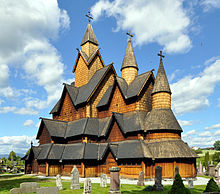
Most Norwegians are registered at baptism as members of the Church of Norway, which has been Norway's state church since its establishment. In recent years the church has been granted increasing internal autonomy, but it retains its special constitutional status and other special ties to the state, and the constitution requires that the reigning monarch must be a member and states that the country's values are based on its Christian and humanist heritage. Many remain in the church to participate in the community and practices such as baptism, confirmation, marriage and burial rites. About 70.6% of Norwegians were members of the Church of Norway in 2017. In 2017, about 53.6% of all newborns were baptised and about 57.9% of all 15-year-old persons were confirmed in the church.[242]
In the early 1990s, studies estimated that between 4.7% and 5.3% of Norwegians attended church on a weekly basis.[243] This figure has dropped to about 2%.[244][245]
In 2010, 10% of the population was religiously unaffiliated, while another 9%, were members of religious communities outside the Church of Norway.[246] Other Christian denominations total about 4.9%[246] of the population, the largest of which is the Roman Catholic Church, with 83,000 members, according to 2009 government statistics.[247] le Aftenposten (Norwegian, The Evening Post) in October 2012 reported there were about 115,234 registered Roman Catholics in Norway; the reporter estimated that the total number of people with a Roman Catholic background may be 170,000–200,000 or higher.[248]
Others include Pentecostals (39,600),[247] the Evangelical Lutheran Free Church of Norway (19,600),[247] Methodists (11,000),[247] Baptists (9,900),[247] Eastern Orthodox (9,900),[247] Brunstad Christian Church (6,800),[247] Seventh-day Adventists (5,100),[247] Assyrians and Chaldeans, and others. The Swedish, Finnish and Icelandic Lutheran congregations in Norway have about 27,500 members in total.[247] Other Christian denominations comprise less than 1% each, including 4,000 members in The Church of Jesus Christ of Latter-day Saints and 12,000 Jehovah's Witnesses.[247]

Among non-Christian religions, Islam is the largest, with 132,135 registered members (2014), and probably fewer than 200,000 in total.[249] It is practised mainly by Somali, Arab, Bosniak, Kurdish and Turkish immigrants, as well as Norwegians of Pakistani descent.
Other religions comprise less than 1% each, including 819 adherents of Judaism.[250] Indian immigrants introduced Hinduism to Norway, which in 2011 has slightly more than 5,900 adherents, or 1% of non-Lutheran Norwegians.[250] Sikhism has approximately 3,000 adherents, with most living in Oslo, which has two gurdwaras. Sikhs first came to Norway in the early 1970s. The troubles in Punjab after Operation Blue Star and riots committed against Sikhs in India after the assassination of Indira Gandhi led to an increase in Sikh refugees moving to Norway. Drammen also has a sizeable population of Sikhs; the largest gurdwara in north Europe was built in Lier. There are eleven Buddhist organisations, grouped under the Buddhistforbundet organisation, with slightly over 14,000 members,[250] which make up 0.2% of the population. The Baha'i religion has slightly more than 1,000 adherents.[250] Around 1.7% (84,500) of Norwegians belong to the secular Norwegian Humanist Association.
From 2006 to 2011, the fastest-growing religious communities in Norway were Eastern Orthodox Christianity and Oriental Orthodox Christianity, which grew in membership by 80%; however, their share of the total population remains small, at 0.2%. It is associated with the huge immigration from Eritrea and Ethiopia, and to a lesser extent from Central and Eastern European and Middle Eastern countries. Other fast-growing religions were the Roman Catholic Church (78.7%), Hinduism (59.6%), Islam (48.1%), and Buddhism (46.7%).[251]
As in other Scandinavian countries, the ancient Norse followed a form of native Germanic paganism known as Norse paganism. By the end of the 11th century, when Norway had been Christianised, the indigenous Norse religion and practices were prohibited. Remnants of the native religion and beliefs of Norway survive today in the form of names, referential names of cities and locations, the days of the week, and other parts of everyday language. Modern interest in the old ways has led to a revival of pagan religious practices in the form of Åsatru. The Norwegian Åsatrufellesskapet Bifrost formed in 1996; in 2011, the fellowship had about 300 members. Foreningen Forn Sed was formed in 1999 and has been recognised by the Norwegian government.
The Sámi minority retained their shamanistic religion well into the 18th century, when most converted to Christianity under the influence of Dano-Norwegian Lutheran missionaries. Although some insist that "indigenous Sámi religion had effectively been eradicated,'[252] athropologist Gutorm Gjessing's Changing Lapps (1954) argues that the Sámi's "were outwardly and to all practical purposes converted to Christianity, but at the subconscious and unconscious level, the shamistic frenzy survived, more or less latent, only awaiting the necessary stimulus to break out into the open."[253] Today there is a renewed appreciation for the Sámi traditional way of life, which has led to a revival of Noaidevuohta.[254] Some Norwegian and Sámi celebrities are reported to visit shamans for guidance.[255][256]
According to the 2010 Eurobarometer Poll, 22% of Norwegian citizens responded that "they believe there is a God", 44% responded that "they believe there is some sort of spirit or life force" and 29% responded that "they don't believe there is any sort of spirit, God or life force". Five percent gave no response.[257]
Santé
Norway was awarded first place according to the UN's Human Development Index (HDI) for 2013.[258] In the 1800s, by contrast, poverty and communicable diseases dominated in Norway together with famines and epidemics. From the 1900s, improvements in public health occurred as a result of development in several areas such as social and living conditions, changes in disease and medical outbreaks, establishment of the health care system, and emphasis on public health matters. Vaccination and increased treatment opportunities with antibiotics resulted in great improvements within the Norwegian population. Improved hygiene and better nutrition were factors that contributed to improved health.
The disease pattern in Norway changed from communicable diseases to non-communicable diseases and chronic diseases as cardiovascular disease. Inequalities and social differences are still present in public health in Norway today.[259]
In 2013 the infant mortality rate was 2.5 per 1,000 live births among children under the age of one. For girls it was 2.7 and for boys 2.3, which is the lowest infant mortality rate for boys ever recorded in Norway.[260]
Éducation
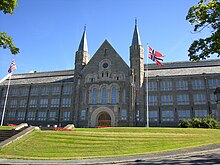
Higher education in Norway is offered by a range of seven universities, five specialised colleges, 25 university colleges as well as a range of private colleges. Education follows the Bologna Process involving Bachelor (3 years), Master (2 years) and PhD (3 years) degrees.[261] Acceptance is offered after finishing upper secondary school with general study competence.
Public education is virtually free, regardless of nationality.[262] The academic year has two semesters, from August to December and from January to June. The ultimate responsibility for the education lies with the Norwegian Ministry of Education and Research.
Culture

The Norwegian farm culture continues to play a role in contemporary Norwegian culture. In the 19th century, it inspired a strong romantic nationalistic movement, which is still visible in the Norwegian language and media. Norwegian culture blossomed with nationalist efforts to achieve an independent identity in the areas of literature, art and music. This continues today in the performing arts and as a result of government support for exhibitions, cultural projects and artwork.[263]
Human rights
Norway has been considered a progressive country, which has adopted legislation and policies to support women's rights, minority rights, and LGBT rights. As early as 1884, 171 of the leading figures, among them five Prime Ministers for the Liberal Party and the Conservative Party, co-founded the Norwegian Association for Women's Rights.[264] They successfully campaigned for women's right to education, women's suffrage, the right to work, and other gender equality policies. From the 1970s, gender equality also came high on the state agenda, with the establishment of a public body to promote gender equality, which evolved into the Gender Equality and Anti-Discrimination Ombud. Civil society organisations also continue to play an important role, and the women's rights organisations are today organised in the Norwegian Women's Lobby umbrella organisation.
In 1990, the Norwegian constitution was amended to grant absolute primogeniture to the Norwegian throne, meaning that the eldest child, regardless of gender, takes precedence in the line of succession. As it was not retroactive, the current successor to the throne is the eldest son of the King, rather than his eldest child. The Norwegian constitution Article 6 states that "For those born before the year 1990 it shall…be the case that a male shall take precedence over a female."[265]

The Sámi people have for centuries been the subject of discrimination and abuse by the dominant cultures in Scandinavia and Russia, those countries claiming possession of Sámi lands.[266] The Sámi people have never been a single community in a single region of Sápmi.[267] Norway has been greatly criticised by the international community for the politics of Norwegianization of and discrimination against the indigenous population of the country.[268] Nevertheless, Norway was, in 1990, the first country to recognise ILO-convention 169 on indigenous people recommended by the UN.
In regard to LGBT rights, Norway was the first country in the world to enact an anti-discrimination law protecting the rights of gays and lesbians. In 1993, Norway became the second country to legalise civil union partnerships for same-sex couples, and on 1 January 2009 Norway became the sixth country to grant full marriage equality to same-sex couples. As a promoter of human rights, Norway has held the annual Oslo Freedom Forum conference, a gathering described by L'économiste as "on its way to becoming a human-rights equivalent of the Davos economic forum."[269]
Cinéma
The Norwegian cinema has received international recognition. The documentary film Kon-Tiki (1950) won an Academy Award. In 1959, Arne Skouen's Nine Lives was nominated, but failed to win. Another notable film is Flåklypa Grand Prix (English: Pinchcliffe Grand Prix), an animated feature film directed by Ivo Caprino. The film was released in 1975 and is based on characters from Norwegian cartoonist Kjell Aukrust. It is the most widely seen Norwegian film of all time.
Nils Gaup's Éclaireur (1987), the story of the Sámi, was nominated for an Oscar. Berit Nesheim's The Other Side of Sunday was nominated for an Oscar in 1997.
Since the 1990s, the film industry has thrived, producing up to 20 feature films each year. Particular successes were Kristin Lavransdatter, based on a novel by a Nobel Prize winner; The Telegraphist et Gurin with the Foxtail. Knut Erik Jensen was among the more successful new directors, together with Erik Skjoldbjærg, who is remembered for Insomnie.[270]
The country has also been used as filming location for several Hollywood and other international productions, including L'empire contre-attaque (1980), for which the producers used Hardangerjøkulen glacier as a filming location for scenes of the ice planet Hoth. It included a memorable battle in the snow. The films Die Another Day, La boussole dorée, Spies Like Us et Heroes of Telemark, as well as the TV series Lilyhammer et Les vikings also had scenes set in Norway.[271] A short film, The Spirit of Norway was featured at Maelstrom at Norway Pavilion at Epcot located within Walt Disney World Resort in Florida in the United States. The attraction and the film ceased their operations on 5 October 2014.
La musique
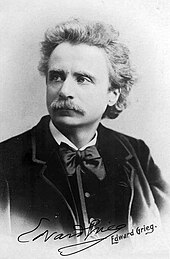
The classical music of the romantic composers Edvard Grieg, Rikard Nordraak and Johan Svendsen is internationally known, as is the modern music of Arne Nordheim. Norway's classical performers include Leif Ove Andsnes, one of the world's more famous pianists; Truls Mørk, an outstanding cellist; and the great Wagnerian soprano Kirsten Flagstad.
Norwegian black metal, a form of rock music in Norway, has been an influence in world music since the late 20th century. Since the 1990s, Norway's export of black metal, a lo-fi, dark and raw form of heavy metal, has been developed by such bands as Emperor, Darkthrone, Gorgoroth, Mayhem, Burzum, and Immortal. More recently bands such as Enslaved, Kvelertak, Dimmu Borgir and Satyricon have evolved the genre into the present day while still garnering worldwide fans. Controversial events associated with the black metal movement in the early 1990s included several church burnings and two prominent murder cases.
The jazz scene in Norway is thriving. Jan Garbarek, Terje Rypdal, Mari Boine, Arild Andersen, and Bugge Wesseltoft are internationally recognised while Paal Nilssen-Love, Supersilent, Jaga Jazzist and Wibutee are becoming world-class artists of the younger generation.[272]
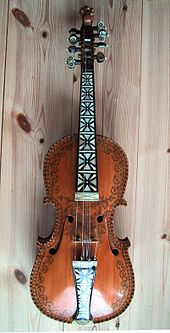
Norway has a strong folk music tradition which remains popular to this day.[273] Among the most prominent folk musicians are Hardanger fiddlers Andrea Een, Olav Jørgen Hegge and Annbjørg Lien, and the vocalists Agnes Buen Garnås, Kirsten Bråten Berg and Odd Nordstoga.
Other internationally recognised bands are A-ha, Röyksopp, Ylvis.[274] A-ha initially rose to global fame during the mid-1980s. In the 1990s and 2000s, the group maintained its popularity domestically, and has remained successful outside Norway, especially in Germany, Switzerland, France, and Brazil.
Some of the most memorable female solo artists from Norway are Susanne Sundfør, Astrid S, Adelén, Julie Bergan, Maria Mena, Tone Damli, Margaret Berger, Lene Marlin, Christel Alsos, Maria Arredondo, Marion Raven, Marit Larsen; both former members of the defunct pop-rock group M2M, Lene Nystrøm vocalist of the Danish eurodance group Aqua, and Anni-Frid Lyngstad vocalist of the Swedish pop group ABBA.
In recent years, various Norwegian songwriters and production teams have contributed to the music of other international artists. The Norwegian production team Stargate has produced songs for Rihanna, Beyoncé, Shakira, Jennifer Lopez and Lionel Richie, among others. Espen Lind has written and produced songs for Beyoncé, Lionel Richie and Leona Lewis, among others. Lene Marlin has written songs for Rihanna and Lovebugs. Ina Wroldsen has written songs for artists such as Demi Lovato, Shakira, Inna, Sophie Ellis-Bextor, One Direction and The Saturdays among others.
Norway enjoys many music festivals throughout the year, all over the country. Norway is the host of one of the world's biggest extreme sport festivals with music, Ekstremsportveko—a festival held annually in Voss. Oslo is the host of many festivals, such as Øyafestivalen and by:Larm. Oslo used to have a summer parade similar to the German Love Parade. In 1992, the city of Oslo wanted to adopt the French music festival Fête de la Musique. Fredrik Carl Størmer established the festival. Even in its first year, "Musikkens Dag" gathered thousands of people and artists in the streets of Oslo. "Musikkens Dag" is now renamed Musikkfest Oslo.
Littérature
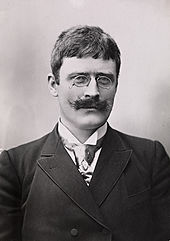
The history of Norwegian literature starts with the pagan Eddaic poems and skaldic verse of the 9th and 10th centuries, with poets such as Bragi Boddason and Eyvindr skáldaspillir. The arrival of Christianity around the year 1000 brought Norway into contact with European mediaeval learning, hagiography and history writing. Merged with native oral tradition and Icelandic influence, this influenced the literature written in the late 12th and early 13th centuries. Major works of that period include Historia Norwegiæ, Þiðrekssaga et Konungs skuggsjá.
Little Norwegian literature came out of the period of the Scandinavian Union and the subsequent Dano-Norwegian union (1387–1814), with some notable exceptions such as Petter Dass and Ludvig Holberg. In his play Peer Gynt, Ibsen characterised this period as "Twice two hundred years of darkness/brooded o'er the race of monkeys." The first line of this couplet is frequently quoted. During the union with Denmark, the government imposed using only written Danish, which decreased the writing of Norwegian literature.

Two major events precipitated a major resurgence in Norwegian literature: in 1811 a Norwegian university was established in Christiania. Secondly, seized by the spirit of revolution following the American and French revolutions, the Norwegians created their first Constitution in 1814. Strong authors were inspired who became recognised first in Scandinavia, and then worldwide; among them were Henrik Wergeland, Peter Christen Asbjørnsen, Jørgen Moe and Camilla Collett.
By the late 19th century, in the Golden Age of Norwegian literature, the so-called "Great Four" emerged: Henrik Ibsen, Bjørnstjerne Bjørnson, Alexander Kielland, and Jonas Lie. Bjørnson's "peasant novels", such as Ein glad gut (A Happy Boy) and Synnøve Solbakken, are typical of the Norwegian romantic nationalism of their day. Kielland's novels and short stories are mostly naturalistic. Although an important contributor to early romantic nationalism, (especially Peer Gynt), Henrik Ibsen is better known for his pioneering realistic dramas such as The Wild Duck et A Doll's House. They caused an uproar because of his candid portrayals of the middle classes, complete with infidelity, unhappy marriages, and corrupt businessmen.
In the 20th century, three Norwegian novelists were awarded the Nobel Prize in Literature: Bjørnstjerne Bjørnson in 1903, Knut Hamsun for the book Markens grøde ("Growth of the Soil") in 1920, and Sigrid Undset (known for Kristinlavransdatter) in 1928. Writers such as the following also made important contributions: Dag Solstad, Jon Fosse, Cora Sandel, Olav Duun, Olav H. Hauge, Gunvor Hofmo, Stein Mehren, Kjell Askildsen, Hans Herbjørnsrud, Aksel Sandemose, Bergljot Hobæk Haff, Jostein Gaarder, Erik Fosnes Hansen, Jens Bjørneboe, Kjartan Fløgstad, Lars Saabye Christensen, Johan Borgen, Herbjørg Wassmo, Jan Erik Vold, Rolf Jacobsen, Olaf Bull, Jan Kjærstad, Georg Johannesen, Tarjei Vesaas, Sigurd Hoel, Arnulf Øverland, Karl Ove Knausgård and Johan Falkberget.
Recherche
Internationally recognised Norwegian scientists include the mathematicians Niels Henrik Abel, Sophus Lie and Atle Selberg, physical chemist Lars Onsager, physicist Ivar Giaever, chemists Odd Hassel, Peter Waage, and Cato Maximilian Guldberg.
In the 20th century, Norwegian academics have been pioneering in many social sciences, including criminology, sociology and peace and conflict studies. Prominent academics include Arne Næss, a philosopher and founder of deep ecology; Johan Galtung, the founder of peace studies; Nils Christie and Thomas Mathiesen, criminologists; Fredrik Barth, a social anthropologist; Vilhelm Aubert, Harriet Holter and Erik Grønseth, sociologists; Tove Stang Dahl, a pioneer of women's law; Stein Rokkan, a political scientist; and economists Ragnar Frisch, Trygve Haavelmo, and Finn E. Kydland.
In 2014, the two Norwegian scientists May-Britt Moser and Edvard Moser won the Nobel Prize in Physiology or Medicine along with John O'Keefe. They won the prize for their groundbreaking work identifying the cells that make up a positioning system in the human brain, our "in-built GPS".[275]
Architecture
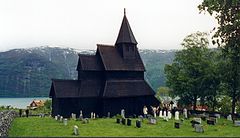
With expansive forests, Norway has long had a tradition of building in wood. Many of today's most interesting new buildings are made of wood, reflecting the strong appeal that this material continues to hold for Norwegian designers and builders.[276]

With Norway's conversion to Christianity some 1,000 years ago, churches were built. Stonework architecture was introduced from Europe for the most important structures, beginning with the construction of Nidaros Cathedral in Trondheim. In the early Middle Ages, wooden stave churches were constructed throughout Norway. Some of them have survived; they represent Norway's most unusual contribution to architectural history. A fine example, Urnes Stave Church in inner Sognefjord, is on UNESCO's World Heritage List. Another notable example of wooden architecture is the buildings at Bryggen Wharf in Bergen, also on the list for World Cultural Heritage sites, consisting of a row of tall, narrow wooden structures along the quayside.

In the 17th century, under the Danish monarchy, cities and villages such as Kongsberg and Røros were established. The city Kongsberg had a church built in the Baroque style. Traditional wooden buildings that were constructed in Røros have survived.
After Norway's union with Denmark was dissolved in 1814, Oslo became the capital. The architect Christian H. Grosch designed the earliest parts of the University of Oslo, the Oslo Stock Exchange, and many other buildings and churches constructed in that early national period.
At the beginning of the 20th century, the city of Ålesund was rebuilt in the Art Nouveau style, influenced by styles of France. The 1930s, when functionalism dominated, became a strong period for Norwegian architecture. It is only since the late 20th century that Norwegian architects have achieved international renown. One of the most striking modern buildings in Norway is the Sámi Parliament in Kárášjohka, designed by Stein Halvorson and Christian Sundby. Its debating chamber, in timber, is an abstract version of a lavvo, the traditional tent used by the nomadic Sámi people.[277]
Art

For an extended period, the Norwegian art scene was dominated by artwork from Germany and Holland as well as by the influence of Copenhagen. It was in the 19th century that a truly Norwegian era began, first with portraits, later with impressive landscapes. Johan Christian Dahl (1788–1857), originally from the Dresden school, eventually returned to paint the landscapes of western Norway, defining Norwegian painting for the first time."[278]
Norway's newly found independence from Denmark encouraged painters to develop their Norwegian identity, especially with landscape painting by artists such as Kitty Kielland, a female painter who studied under Hans Gude, and Harriet Backer, another pioneer among female artists, influenced by impressionism. Frits Thaulow, an impressionist, was influenced by the art scene in Paris as was Christian Krohg, a realist painter, famous for his paintings of prostitutes.[279]
Of particular note is Edvard Munch, a symbolist/expressionist painter who became world-famous for The Scream which is said to represent the anxiety of modern man.
Other artists of note include Harald Sohlberg, a neo-romantic painter remembered for his paintings of Røros, and Odd Nerdrum, a figurative painter who maintains that his work is not art, but kitsch.
Cuisine
Norway's culinary traditions show the influence of long seafaring and farming traditions, with salmon (fresh and cured), herring (pickled or marinated), trout, codfish, and other seafood, balanced by cheeses (such as brunost), dairy products, and breads (predominantly dark/darker).
Lefse is a Norwegian potato flatbread, usually topped with large amounts of butter and sugar, most common around Christmas. Some traditional Norwegian dishes include lutefisk, smalahove, pinnekjøtt, raspeball, and fårikål.[280] Some quirky Norwegian speciality is rakefisk, which is a fermented trout, consumed with thin flatbread (flatbrød, not lefse) and sour cream. And the most popular pastry among all population is vaffel. It is different from Belgian in taste and consistency and is served with sour cream, brown cheese, butter and sugar, or strawberry or raspberry jam, which can all be mixed or eaten separately.
Des sports

Sports are a central part of Norwegian culture, and popular sports include association football, handball, biathlon, cross-country skiing, ski jumping, speed skating, and, to a lesser degree, ice hockey.
Association football is the most popular sport in Norway in terms of active membership. In 2014–2015 polling, football ranked far behind biathlon and cross-country skiing in terms of popularity as spectator sports.[281] Ice hockey is the biggest indoor sport.[282] The women's handball national team has won several titles, including two Summer Olympics championships (2008, 2012), three World Championships (1999, 2011, 2015), and six European Championship (1998, 2004, 2006, 2008, 2010, 2014).
In association football, the women's national team has won the FIFA Women's World Cup in 1995 and the Olympic Football Tournament in 2000. The women's team also has two UEFA European Women's Championship titles (1987, 1993). The men's national football team has participated three times in the FIFA World Cup (1938, 1994, and 1998), and once in the European Championship (2000). The highest FIFA ranking Norway has achieved is 2nd, a position it has held twice, in 1993 and in 1995.[283]
Chess is also gaining popularity in Norway. Magnus Carlsen is the current world champion.[284] There are about 10 Grandmasters and 29 International Masters in Norway.
Bandy is a traditional sport in Norway and the country is one of the four founders of Federation of International Bandy. In terms of licensed athletes, it is the second biggest winter sport in the world.[285] As of January 2018, the men's national team has captured one silver and one bronze, while the women's national team has managed five bronzes at the World Championships.

Norway first participated at the Olympic Games in 1900, and has sent athletes to compete in every Games since then, except for the sparsely attended 1904 Games and the 1980 Summer Olympics in Moscow when they participated in the American-led boycott. Norway leads the overall medal tables at the Winter Olympic Games with considerable margin. Famous Norwegian winter sport athletes includes biathlete Ole Einar Bjørndalen, speed skaters Johan Olav Koss and Hjalmar Andersen, figure skater Sonja Henie and cross-country skiers Marit Bjørgen and Bjørn Dæhlie.
Norway has hosted the Games on two occasions:
Tourism
As of 2008, Norway ranks 17th in the World Economic Forum's Travel and Tourism Competitiveness Report.[286] Tourism in Norway contributed to 4.2% of the gross domestic product as reported in 2016.[287] Every one in fifteen people throughout the country work in the tourism industry.[287] Tourism is seasonal in Norway, with more than half of total tourists visiting between the months of May and August.[287]
The main attractions of Norway are the varied landscapes that extend across the Arctic Circle. It is famous for its fjord-indented coastline and its mountains, ski resorts, lakes and woods. Popular tourist destinations in Norway include Oslo, Ålesund, Bergen, Stavanger, Trondheim and Tromsø. Much of the nature of Norway remains unspoiled, and thus attracts numerous hikers and skiers. The fjords, mountains and waterfalls in Western and Northern Norway attract several hundred thousand foreign tourists each year. In the cities, cultural idiosyncrasies such as the Holmenkollen ski jump attract many visitors, as do landmarks such as Bergen's Bryggen and Oslo's Vigeland Sculpture Park.
International rankings
Voir également
Remarques
Références
- ^ "Språk i Norge – Store norske leksikon".
- ^ "Minoritetsspråk". Språkrådet.
- ^ kirkedepartementet, Fornyings-, administrasjons- og (16 June 2006). "Samer". Regjeringen.no.
- ^ inkluderingsdepartementet, Arbeids- og (16 June 2006). "Nasjonale minoriteter". Regjeringen.no.
- ^ regjeringen.no (5 July 2011). "The Re-establishing of a Norwegian State". Gouvernement.no.
- ^ une b c ré "Arealstatistics for Norway 2019". Kartverket, mapping directory for Norway. 2019. Récupéré 22 March 2019.
- ^ "Population, 2019-01-01". Statistics Norway. 22 February 2019. Récupéré 16 mars 2019.
- ^ une b c ré "Norvège". International Monetary Fund.
- ^ "Gini coefficient of equivalised disposable income – EU-SILC survey". ec.europa.eu. Eurostat. Récupéré 7 March 2019.
- ^ une b "2017 Human Development Report". United Nations Development Programme. 2017. Récupéré 14 September 2018.
- ^ une b National Research Council (U.S.). Polar Research Board (1986). Antarctic treaty system: an assessment. Science of the Total Environment. 61. National Academies Press. pp. 260–261. Bibcode:1987ScTEn..61..260B. doi:10.1016/0048-9697(87)90375-5. ISBN 978-0-309-03640-5. Récupéré 24 July 2011.
- ^ "Population". Statistics Norway. 22 August 2018. Récupéré 17 novembre 2018.
- ^ Norway, Study in. "Norwegian Society / Living in Norway / StudyinNorway / Home – Study in Norway". www.studyinnorway.no.
- ^ "UPDATE 1-Statistics Norway raises '07 GDP outlook, cuts '08". Reuters. 6 September 2007. Récupéré 8 March 2009.
- ^ "Country Comparison :: Crude oil – production". CIA – The World Factbook. Récupéré 16 mars 2016.
- ^ "Country Comparison :: Natural gas – production". CIA – The World Factbook. Récupéré 16 mars 2016.
- ^ "The World's Richest Countries". forbes.com. Récupéré 12 December 2014.
- ^ "The World Factbook". Central Intelligence Agency Library. Agence centrale de renseignement. Récupéré 23 May 2016.
- ^ Holter, Mikael (27 June 2017). "The World's Biggest Wealth Fund Hits $1 Trillion". Bloomberg L.P. Récupéré 19 September 2017.
- ^ "Human development indices 2008" (PDF). Human Development Report. hdr.undp.org. 18 December 2008. Archived from the original (PDF) on 19 December 2008. Récupéré 12 May 2009.
- ^ une b "Human Development Index 2009" (PDF). Human Development Report. hdr.undp.org. 5 October 2009. Récupéré 5 octobre 2009.
- ^ "Human Development Report 2011" (PDF). Les Nations Unies. Récupéré 2 novembre 2011.
- ^ Norway top country in human well-being. United Press International, 15 March 2013. Retrieved 27 August 2013.
- ^ "Human Development Report 2018 – "Human Development Indices and Indicators"" (PDF). HDRO (Human Development Report Office) United Nations Development Programme. pp. 30–33. Récupéré 14 September 2018.
- ^ Rankin, Jennifer (20 March 2017). "Happiness is on the wane in the US, UN global report finds". Le gardien. Récupéré 20 March 2017.
- ^ "Democracy Index 2016". eiu.com. Récupéré 25 January 2017.
- ^ Norway, Study in. "Why Norway? / Living in Norway / StudyinNorway / Home – Study in Norway". www.studyinnorway.no.
- ^ une b c ré "Nomino 6:6". Nomino. Season 2 (in Norwegian). 4 October 2016. Event occurs at 22:18. NRK. Récupéré 5 octobre 2016.
- ^ une b c ré e "Sår tvil om Norges opphav" (in Norwegian). Forskning.no for Universitetet i Agder.
- ^ Krag, Claus, 2003: "The early unification of Norway." I Knut Helle (red.): The Cambridge history of Scandinavia 1. Prehistory to 1520. Cambridge: Cambridge University Press. 184-201.
- ^ une b Heide, Eldar, 2017: "Noregr tyder nok vegen mot nord, likevel".Namn og nemne, 2016. Vol 33, 13–37.
- ^ Stenton, F. M. (1945). Presidential Address: The Scandinavian Colonies in England and Normandy. Transactions of the Royal Historical Society, 27, 1-12.
- ^ deGorog, R. P. (1961). A note on Scandinavian Influence in Normandy and in Finland. Modern Language Notes, 76(8), 840-847.
- ^ Snorri Sturluson (1967). From the sagas of the Norse kings. Translated by A.H. Smith. Oslo: Dreyer.
- ^ Melberg, Håkon (1951). Origin of the Scandinavian nations and languages: an introduction. Halden: H. Melberg.
- ^ Helle, Knut: «Ei soge om Vestlandet». Volume 1 of Vestlandets historie (edited by Knut Helle). Bergen: Vigmostad og Bjørke, 2006.
- ^ une b Sigurðsson and Riisøy: Norsk historie 800–1536p. 24
- ^ Orning, Hans Jacob: En vestlandskonge? Klassekampen, 18. februar 2013.
- ^ Simonsen, Povl (1957). Ottar fra Hålogaland. Tromsø: Tromsø museum.
- ^ Molin, Karl Reinholdt (1954). Fortellinger: av Nord-Norges historie. Fylkestrykkeriet i Troms.
- ^ Storli, Inger (red.) (1995). Ottars verden. Tromsø, Tromsø museum.
- ^ Dieserud, J.: Norse and Norseman versus Norwegian. Scandinavian Studies and Notes Vol. 8, No. 8 (november 1925), pp. 233-238)
- ^ Passarino, G; Cavalleri, G. L.; Lin, A. A.; Cavalli-Sforza, L. L.; Børresen-Dale, A. L.; Underhill, P. A. (2002). "Different genetic components in the Norwegian population revealed by the analysis of mtDNA and Y chromosome polymorphisms". European Journal of Human Genetics. dix (9): 521–529. doi:10.1038/sj.ejhg.5200834. PMID 12173029.
- ^ Ling 2008. Elevated Rock Art. GOTARC Serie B. Gothenburg Archaeological Thesis 49. Department of Archaeology and Ancient History, University of Gothenburg, Goumlteborg, 2008. ISBN 978-91-85245-34-5.
- ^ Vedel, Bornholms Oldtidsminder og Oldsager, (Copenhagen 1886).
- ^ "Age of the vikings". loststory. Récupéré 17 February 2015.
- ^ "Vinland Archeology". naturalhistory.si.edu. Archived from the original on 8 March 2018. Récupéré 11 April 2017.
- ^ Larsen, p. 83.
- ^ Foster, R. F. (2001) The Oxford History of Ireland. Oxford University Press. ISBN 0-19-280202-X
- ^ Jones, Gwyn, A history of the Vikings (Oxford 2001).
- ^ Larsen, p. 95.
- ^ Larsen, p. 201.
- ^ Stenersen: 36
- ^ Stenersen: 38
- ^ Stenersen: 39
- ^ Stenersen: 37
- ^ Stenersen: 41
- ^ Stenersen: 44
- ^ une b Stenersen: 45
- ^ Stenersen: 46
- ^ Derry p.75
- ^ Derry pp. 77–78
- ^ Derry p.77
- ^ Derry pp. 81–82
- ^ Derry pp.83–84
- ^ Larsen, p. 192.
- ^ Oeding, P (1990). "The black death in Norway". Tidsskrift for den Norske Laegeforening : Tidsskrift for Praktisk Medicin, NY Raekke. 110 (17): 2204–2208. PMID 2197762.
- ^ une b c ré e F g h je j "Black Death (pandemic)". Encyclopædia Britannica. Récupéré 23 July 2011.
- ^ Larsen, pp. 202–203.
- ^ Larsen, p. 195
- ^ Larsen, p. 197
- ^ "Finding the family in medieval and early modern Scotland". Elizabeth Ewan, Janay Nugent (2008). Ashgate Publishing. p.153. ISBN 0-7546-6049-4
- ^ "The savage wars of peace: England, Japan and the Malthusian trap". Alan Macfarlane (1997). p.63. ISBN 0-631-18117-2
- ^ Treaty of Kiel, 14 January 1814.
- ^ Nicolson, Harold (1946). The Congress of Vienna; a study in allied unity, 1812–1822. Constable & co. ltd. p. 295.
The British Government sought to overcome this reluctance by assisting Russia in blockading the coast of Norway
- ^ Larsen, p. 572.
- ^ Larsen, p. 423.
- ^ Franklin D. Scott, Sweden: the Nation's History (University of Minnesota Press: Minneapolis, 1977) p. 380.
- ^ Larsen, p. 432.
- ^ Larsen, p. 431.
- ^ Larsen, p. 412.
- ^ une b See "The Civil War in Switzerland" by Frederick Engels contained in Marx & Engels, Collected Works: Volume 6 (International Publishers, New York, 1976) p. 368.
- ^ Larsen, p. 433.
- ^ "Marcus Møller Thrane – Norwegian journalist and socialist". Encyclopædia Britannica.
- ^ Larsen, p. 510.
- ^ "Norwegian volunteers in the Wehrmacht and SS". Nuav.net. 9 April 1940. Récupéré 5 April 2010.
- ^ PM to light London tree. Aftenposten. 5 December 2007
- ^ Frenzel, Eike (3 September 2010). "Kriegsende in der Arktis: Die vergessenen Haudegen". Spiegel Online. Récupéré 4 novembre 2018.
- ^ "Balder – Norsk Oljemuseum". www.norskolje.museum.no.
- ^ "Norwegian minister Espen Eide urges UK caution on quitting EU". BBC. 23 December 2012. Récupéré 23 December 2012.
- ^ une b Holmesland, Arthur m.fl.: Norge, Oslo: Aschehoug, 1973.
- ^ Kiel-traktaten. Danish translation 1814. Nasjonalbiblioteket/National Library of Norway, read 2 February 2014.
- ^ Schei, Liv K.: Orkenøyene, Oslo: Grøndahl, 1985.
- ^ Helle, Knut & Knut Mykland: Norge blir en stat. 1130-1319. Bergen: Universitetsforlaget, 1964.
- ^ une b Thuesen, Nils Petter; Thorsnæs, Geir; Røvik, Sissel (14 May 2018), "Norge", Store norske leksikon (en norvégien), récupéré 5 July 2018
- ^ "Norge i nord, sør, øst og vest". Kartverket (en norvégien bokmål). 8 March 2013. Récupéré 5 July 2018.
- ^ "Fuglefjellet skal lære folk sjøfuglene å kjenne".
- ^ "Explore North Cape, Europe's northernmost point". L'indépendant. 14 December 2017. Récupéré 5 July 2018.
- ^ "Statistisk årbok 2013: Geografisk oversikt". www.ssb.no. Récupéré 5 July 2018.
- ^ une b c ré Central Intelligence Agency. "Norvège". Le World Factbook. Récupéré 20 June 2013.
- ^ "Minifacts about Norway 2009: 2. Geography, climate and environment". Statistics Norway. Récupéré 25 October 2009.
- ^ Strøm, Kaare (1959). Innsjøenes verden. Oslo: Universitetsforlaget.
- ^ Rogstad, Lars (1985). OPPLEGG FOR RESSURSREGNSKAP FOR VANN notat. Oslo: SSB/Statistics Norway.
- ^ "Norwegian Shelf ecosystem". Eoearth.org. Archived from the original on 1 November 2012. Récupéré 30 mai 2010.
- ^ Bertelsen, Hans Kristian (1985). Sandefjord: A modern city with vast potential. Grafisk Studio. Page 4. ISBN 82-90636-00-8.
- ^ Berman, Martha (1995). Fielding’s Scandinavia. Fielding Worldwide. Page 240. ISBN 9781569520499.
- ^ une b Met.no. "Climate in Norway(English)". Archived from the original on 20 March 2017.
- ^ une b Selected climatic data for a global set of standard stations for vegetation. 6 December 2012. ISBN 9789400980402.
- ^ "Climate mythology: The Gulf Stream, European climate and Abrupt Change".
- ^ NRK (21 August 2016). "Norske steder blant de tørreste i Europa (Places in Norway among the driest in Europe)". NRK. Récupéré 26 August 2016.
- ^ "Climate of Norway: Temperature, Climate graph, Climate table for Norway – Climate-Data.org".
- ^ A study behind the updated maps of Köppen-Geiger climate classification (2007). "Updated world map of the Koppen-Geiger climate classification" (PDF).
- ^ Website with maps (2006). "World map of Köppen-Geiger climate classification updated". Meteorologische Zeitschrift. 15 (3): 259–263. Bibcode:2006MetZe..15..259K. doi:10.1127/0941-2948/2006/0130. Archived from the original on 5 April 2017.
- ^ une b "Normaler for Brønnøy". met.no. Archived from the original on 16 July 2012. Récupéré 7 November 2011.
- ^
"World Weather Information Service – Bergen". World Meteorological Organization. Récupéré 27 October 2013. - ^ "BERGEN – FLORIDA Climate Normals: Temperature 2005–2014, all other data 1961–1990". National Oceanic and Atmospheric Administration. Récupéré 16 mars 2014.
- ^ "Google Domains Hosted Site". Archived from the original on 1 November 2016.
- ^ "Norwegian Met. Institute". Archived from the original on 19 November 2016.
- ^ "NOU 2004". Regjeringen.no. Archived from the original on 11 May 2008. Récupéré 30 mai 2010.
- ^ une b Norwegian Red List 2010. Artsdatabanken.no
- ^ "WWF – Norway's forest heritage under threat" Archived 18 October 2015 at the Wayback Machine. panda.org. 15 April 2003
- ^ "25 Reasons Norway Is The Greatest Place On Earth". The Huffington Post. 7 January 2014.
- ^ Hamashige, Hope. "Best, Worst World Heritage Sites Ranked". Nouvelles National Geographic. Récupéré 25 October 2009.
- ^ Planet, Lonely (2 August 2010). "Norway: come for the sun, stay for the light show – Lonely Planet". Lonely Planet. Récupéré 11 April 2017.
- ^ "Global Metrics for the Environment" (PDF). epi.yale.edu. January 2016. Archived from the original (PDF) on 4 October 2017. Récupéré 23 December 2017.
- ^ "2016 Environmental Performance Index (excel/xls)". epi.yale.edu. January 2016. Récupéré 23 December 2017.[[lien mort permanent]
- ^ Wong, Curtis M. (14 December 2010). World's Top Democratic Governments: Economist Intelligence Unit's Democracy Index 2010 (PHOTOS). The Huffington Post. Retrieved 27 August 2013.
- ^ Sida/Så arbetar vi/EIU_Democracy_Index_Dec2011.pdf Democracy index 2011[[lien mort]. Economiste Intelligence Unit Retrieved 27 August 2013.
- ^ Davidson, Kavitha A. (21 March 2013). Democracy Index 2013: Global Democracy At A Standstill, The Economist Intelligence Unit's Annual Report Shows. The Huffington Post. Retrieved 27 August 2013.
- ^ "The Constitution – Complete text". The Storting's Information Corner. 2011. Archived from the original on 29 August 2011. Récupéré 9 September 2011.
- ^ "The King's constitutional role". The Royal Court of Norway. Récupéré 24 avril 2009.
- ^ une b "The Monarchy". Norway.org. 24 June 2010. Archived from the original on 22 February 2012.
- ^ "The Storting". Norway.org. 10 June 2009. Archived from the original on 26 January 2012.
- ^ Nordsieck, Wolfram (2011). "Parties and Elections in Europe". parties-and-elections.de. Archived from the original on 3 September 2011. Récupéré 10 September 2011.
Storting, 4-year term, 4% threshold (supplementary seats)
- ^ "The Government". Norway.org. 10 June 2009. Archived from the original on 3 September 2010.
- ^ "itemid":%5b"001-81356"%5d} "CASE OF FOLGERØ AND OTHERS v. NORWAY". 29 June 2007. Récupéré 17 mars 2015.
- ^ "På statskirkens siste dag". Dagen.no (en norvégien). Récupéré 4 février 2017.
- ^ "Form of Government". Norway.org. 10 September 2009. Archived from the original on 22 February 2012.
- ^ "Political System of Norway". 123independenceday.com. Récupéré 27 janvier 2010.
- ^ "Political System". Norway.org. 18 November 2009. Archived from the original on 12 April 2010. Récupéré 27 janvier 2010.
- ^ Bevanger, Lars (10 September 2013). "Norway election: Erna Solberg to form new government". BBC. Récupéré 15 février 2014.
- ^ "Local Government". Norway.org. 10 June 2009. Archived from the original on 11 June 2010. Récupéré 27 janvier 2010.
- ^ Rapp, Ole Magnus (21 September 2015). "Norge utvider Dronning Maud Land helt frem til Sydpolen". Aftenposten (in Norwegian). Oslo, Norway: Aftenposten. Récupéré 22 septembre 2015.
…formålet med anneksjonen var å legge under seg det landet som til nå ligger herreløst og som ingen andre enn nordmenn har kartlagt og gransket. Norske myndigheter har derfor ikke motsatt seg at noen tolker det norske kravet slik at det går helt opp til og inkluderer polpunktet.
- ^ une b "The Judiciary". Norway.org. 10 June 2009. Archived from the original on 26 January 2012.
- ^ Worldwide Press Freedom Index 2007, Reporters Without Borders.
- ^ "Global Corruption Barometer 2013-Norway". Transparency International. Archived from the original on 21 October 2014. Récupéré 17 novembre 2013.
- ^ Anders Breivik: Just how cushy are Norwegian prisons? BBC
- ^ "List of Norwegian embassies at the website of the Norwegian ministry of foreign affairs". 6 February 2008. Archived from the original on 6 February 2008. Récupéré 12 October 2013.
- ^ "Refleksjoner fra Brussel – Hospitering ved Sørlandets Europakontor – Vest-Agder Fylkeskommune". Intportal.vaf.no. 4 January 2010. Archived from the original on 6 June 2013.
- ^ "EU-programmer". Eu-norge.org. 30 June 2009. Archived from the original on 1 May 2011. Récupéré 29 August 2010.
- ^ "NDF official numbers". NDF. Archived from the original on 12 April 2009. Récupéré 22 avril 2009.
- ^ Gwladys Fouche and Balazs Koranyi (14 June 2013): "Norway becomes first NATO country to draft women into military", Reuters. Retrieved 15 June 2013.
- ^ "Forsvarsnett: Norwegian forces abroad". mil.no. Archived from the original on 29 September 2008. Récupéré 2 September 2008.
- ^ Baltais, Simon (2010). "Environment And Economy: Can They Co-Exist In The "Smart State"?". Problèmes. 91: 21–24.
- ^ A Family Affair: Intergenerational Social Mobility across OECD Countries. OECD, 2010. Retrieved 27 August 2013.
- ^ "OECD Better Life Index". OCDE. Récupéré 27 August 2013.
- ^ "NAV – Foreldrepenger ved fødsel". Nav.no. 2011. Archived from the original on 26 February 2010. Récupéré 18 April 2011.
- ^ "Labour force survey, seasonally-adjusted figures, September 2016". Statistics Norway. September 2016. Récupéré 17 décembre 2016.
- ^ "Labour force survey – About the statistics – SSB". Ssb.no. 30 October 2013. Récupéré 15 février 2014.
- ^ "Statistical Yearbook of Norway 2013, Table 144: National Insurance. Disability pension, by county. 31 December 2012". Ssb.no. 31 December 2012. Récupéré 15 février 2014.
- ^ "Dette er Norge" (in Norwegian). Statistics Norway. Récupéré 2 January 2013.
- ^ Bureau of Labor Statistics. "International Comparisons of GDP per Capita and per Hour, 1960–2010" (PDF). Division of International Labor Comparisons. Récupéré 16 mars 2016.
- ^ "Hourly Compensation Costs, U.S. Dollars and U.S. = 100." United States Department of Labor: Bureau of Labor Statistics, 21 December 2011. Web. 18 September 2012.
- ^ Central Intelligence Agency. "Country Comparison: Distribution of Family Income – GINI Index". Le World Factbook. Récupéré 20 June 2013.
- ^ "EØS-loven – EØSl. Lov om gjennomføring i norsk rett av hoveddelen i avtale om Det europeiske økonomiske samarbeidsområde (EØS) m.v. (EØS-loven)". Lovdata.no. Récupéré 14 February 2009.
- ^ "Norway," U.S. Department of State
- ^ "Norway becomes first country to ban deforestation".
- ^ "Secondary Industries". This is Norway. Statistics Norway. 15 March 2009. p. 40. Récupéré 24 March 2013.
- ^ une b c ré e F Ole Mathismoen (5 August 2013) Aftenposten p. 5
- ^ une b c ré Lindeberg, Anne (6 September 2013). "Her er Norges nye oljeprovins". Dn.no. Récupéré 12 October 2013.
- ^ une b "Gass- og oljefunn nord for Snøhvitfeltet i Barentshavet – 7220/8-1". Npd.no. 1 April 2011. Récupéré 12 October 2013.
- ^ "FAO Globefish global trends 2006". Archived from the original on 10 October 2017. Récupéré 8 March 2009.
- ^ "Mener Norge bør satse på våpen når oljen tar slutt – VG Nett om Stoltenberg-regjeringen". Vg.no. Récupéré 7 March 2011.
- ^ handelsdepartementet, Nærings- og (18 May 2000). "Norsk næringsvirksomhet – Strukturen i norsk økonomi". Regjeringen.no (en norvégien). Récupéré 3 October 2018.
- ^ "Norsk næringsliv". ssb.no (en norvégien bokmål). Récupéré 3 October 2018.
- ^ "Binge and purge". L'économiste. 22 January 2009. Récupéré 30 January 2009.
98–99% of Norway's electricity comes from hydroelectric plants.
- ^ "Mineral Resources in Norway in 2013" (PDF).
- ^ Stanley Reed (24 June 2014). "Norway's Sovereign Wealth Fund Ramps Up Investment Plans". Le New York Times. Récupéré 27 April 2015.
The fund, the world's largest sovereign wealth fund …
- ^ "Transparency". www.nbim.no. Récupéré 22 November 2018.
- ^ "Subscribe to read". Financial Times. Récupéré 22 November 2018.
- ^ Norwegian Ministry of Transport and Communication, 2003: 3
- ^ "Majority in Favor of High-Speed Trains". Theforeigner.no. Archived from the original on 24 July 2011. Récupéré 23 July 2011.
- ^ Skjeggestad, Sveinung Berg Bentzrød Helene (7 March 2011). "De aller fleste sier ja takk til lyntog". Aftenposten (en norvégien bokmål). Récupéré 23 February 2019.
- ^ Norwegian National Rail Administration, 2008: 4
- ^ une b Norwegian National Rail Administration. "Sur". Archived from the original on 16 December 2007. Récupéré 15 July 2008.
- ^ Norwegian National Rail Administration, 2008: 13
- ^ Norwegian National Rail Administration, 2008: 16
- ^ Norwegian Ministry of Transport (16 June 2006). "Kollektivtransport" (in Norwegian). Récupéré 15 July 2008.
- ^ Norges Statsbaner. "Train facts". Archived from the original on 12 June 2008. Récupéré 15 July 2008.
- ^ Norwegian Ministry of Transport and Communications, 2003: 15
- ^ "Electric cars take off in Norway". L'indépendant. Agence France-Presse. 15 May 2011. Archived from the original on 17 May 2011. Récupéré 9 October 2011.
- ^ European Association for Battery, Hybrid and Fuel Cell Electric Vehicles (AVERE) (3 September 2012). "Norwegian Parliament extends electric car initiatives until 2018". AVERE. Archived from the original on 3 February 2017. Récupéré 10 April 2013.
- ^ Hannisdahl, Ole Henrik (9 January 2012). "Eventyrlig elbilsalg i 2011" [Adventurous electric vehicle sales in 2011] (in Norwegian). Grønn bil. Archived from the original on 7 February 2012. Récupéré 14 January 2012. See table "Elbilsalg i 2011 fordelt på måned og merke" (Electric vehicle sales in 2011, by month and brand) to see monthly sales for 2011.
- ^ "Elbilsalget i mars slo alle rekorder" [Electric vehicle sales in March broke all records] (in Norwegian). Grønn bil. 2 April 2014. Archived from the original on 5 April 2014. Récupéré 3 April 2014.
- ^ Cobb, Jeff (16 January 2014). "Top 6 Plug-In Vehicle Adopting Countries". HybridCars.com. Récupéré 28 January 2015.
- ^ Siu, Jason (6 June 2016). "Norway Wants to Make Gas-Powered Cars Illegal by 2025". AutoGuide.com. VerticalScope Inc. Récupéré 7 juin 2016.
- ^ "Electric cars reach record 42% of Norway's total new car sales with boost from Tesla Model X | Electrek". Electrek.co. 4 July 2017. Récupéré 23 septembre 2017.
- ^ une b c ré Avinor (2008). "2007 Passasjerer" (in Norwegian). Archived from the original on 28 December 2010. Récupéré 15 July 2008.
- ^ Avinor. "About Avinor". Archived from the original on 31 March 2008. Récupéré 15 July 2008.
- ^ Scandinavian Airlines System. "Rutekart". Archived from the original on 28 June 2012. Récupéré 15 July 2008.
- ^ Norwegian Air Shuttle. "Route Map". Archived from the original on 14 July 2008. Récupéré 15 July 2008.
- ^ Widerøe. "Våre destinasjoner". Archived from the original on 15 August 2008. Récupéré 15 July 2008.
- ^ Oslo Lufthavn. "Car". Archived from the original on 1 June 2008. Récupéré 15 July 2008.
- ^ Oslo Lufthavn. "International scheduled routes from Oslo". Archived from the original on 14 July 2008. Récupéré 15 July 2008.
- ^ https://snl.no/språk_i_Norge
- ^ Norges grunnlov, § 108 (Constitution of Norway, article 108, mention the Sámi language specifically)
- ^ kirkedepartementet, Kultur- og (27 June 2008). "St.meld. nr. 35 (2007–2008)".
- ^ "Nordens språk med røtter og føtter–Samiske språk". Eplads.norden.org. Récupéré 26 March 2013.
- ^ "Lov om Sametinget og andre samiske rettsforhold (sameloven) – Lovdata". lovdata.no.
- ^ "NOU 1995: 18 – Ny lovgivning om opplæring". Kunnskapsdepartementet. 4 July 1995. Archived from the original on 27 October 2014.
- ^ "Kvener – Kainun institutti – Kvensk institutt". Kvenskinstitutt.no. Récupéré 26 March 2013.
- ^ "Minoritetsspråkpakten". Fornyings-, administrasjons- og kirkedepartementet. 26 October 2018.
- ^ "St.meld. nr. 35 (2007–2008) – Mål og meining". Kulturdepartementet. Archived from the original on 27 October 2014.
- ^ "St.meld. nr. 35. Mål og meining : Ein heilskapleg norsk språkpolitikk". Kultur- og kirkedepartementet. 27 June 2008.
- ^ "Tegnspråk blir offisielt språk". NRK. 26 June 2008.
- ^ "Tabell 0 Hele landet. Folkemengde 1. januar og endringer i året. 1951" (in Norwegian). Statistics Norway. Récupéré 27 janvier 2007.
- ^ "Population 1 January. Registered 2010. Projected 2011–2060 in fourteen variants. 1 000". Statistics Norway. Archived from the original on 16 October 2011. Récupéré 27 janvier 2010.
- ^ https://www.ssb.no/en/befolkning/nokkeltall
- ^ Max Roser (2014), "Total Fertility Rate around the world over the last centuries", Our World In Data, Gapminder Foundation
- ^ Persons with immigrant background by immigration category, country background and gender. 1 January 2012 (Corrected 30 April 2012). ssb.no
- ^ une b c Questions about immigrant-related statistics (20 June 2013). "Key figures Immigration and immigrants – SSB". Ssb.no. Récupéré 15 février 2014.
- ^ une b c ré 12 prosent av befolkningen er innvandrere Statistics Norway (en norvégien) retrieved 26 April 2013
- ^ "Three categories of immigration background, country of birth and citizenship by country background and sex. 1 January 2012". Statistics Norway. 26 April 2012. Retrieved 27 April 2012. Archived 7 August 2011.
- ^ une b Innvandrere og norskfødte med innvandrerforeldre, 25 April 2013 Statistics Norway. Retrieved 30 December 2013
- ^ Hare, Sophie. "Factbox – facts about Norway", Reuters. 22 July 2011. Retrieved 22 July 2011.
- ^ Eivind Bråstad Jensen. 1991. Fra fornorskningspolitikk mot kulturelt mangfold. Nordkalott-Forlaget.
- ^ I. Bjørklund, T. Brantenberg, H. Eidheim, J.A. Kalstad and D. Storm. 2002. Australian Indigenous Law Reporter (AILR) 1 7(1)
- ^ Bureau, U.S. Census. "American FactFinder – Results". factfinder.census.gov.
- ^ "Population: Key figures for the population". ssb.no.
- ^ Statistics Canada (8 May 2013). "2011 National Household Survey: Data tables". Récupéré 11 February 2014.
- ^ "Netto innvandring, etter land. 1966–2011" (in Norwegian). Statistics Norway. Archived from the original on 20 November 2012. Récupéré 2 September 2012.
- ^ Ladegaard, Isac (7 May 2012). "Polish workers get stuck in stereotype". Science Nordic.
- ^ "Population and quarterly changes, Q4 2012". Statistics Norway. 21 February 2013. Récupéré 24 March 2013.
- ^ "Immigrants and Norwegian-born to immigrant parents, 1 January 2012". Statistics Norway. 26 April 2012. Récupéré 24 March 2013.
- ^ "Immigrants and Norwegian-born to immigrant parents, 1 January 2017". Statistics Norway (in Norwegian).
- ^ "Immigrants and Norwegian-born to immigrant parents, 1 January 2017". Statistics Norway. 2 March 2017. Récupéré 9 June 2017. See Table 3 "Population by immigrant category and country background", sum of columns "Immigrants" and "Norwegian-born to immigrant parents".
- ^ "Population 1 January 2011 and 2012 and changes in 2011, by immigration category and country background". Statistics Norway. 2012. Récupéré 24 March 2013.
- ^ Fraser, Sean (15 May 2012). "Norway abolishes state-sponsored Church of Norway". Digital Journal. Récupéré 20 June 2013.
- ^ "Norway and its national church part ways". 5 January 2017.
- ^ På vei mot ny kirkeordning Den Norske Kirke. Retrieved: 12 December 2017.
- ^ Norwegian Church passes milestone in modification of its links with State Church Times, 6 January 2017.
- ^ Church of Norway, 2017 4 June 2018 Statistics Norway
- ^ "The People in the Church". dawnnorge.no. Archived from the original on 15 August 2007.
- ^ "KOSTRA (Municipality-State-Reporting): Church". Statistics Norway. Récupéré 29 August 2010.
- ^ "Church of Norway. Church services and participants, by diocese. 2005–2009 (Corrected 28 June 2010)". Statistics Norway. 28 June 2010. Récupéré 7 March 2011.
- ^ une b "More members in religious and philosophical communities". Statistics Norway. Récupéré 8 March 2009.
- ^ une b c ré e F g h je j "Members of Christian communities outside the Church of Norway". Statistics Norway. Récupéré 21 août 2010.
- ^ Andreas Sletteholm: "Nå er det flere katolikker enn muslimer i Norge", Aftenposten, 3 December 2012
- ^ "Church of Norway and other religious and philosophical communities". Statistics Norway. Récupéré 9 December 2011.
- ^ une b c ré "Members of religious and life-stance communities outside the Church of Norway, by religion/life stance". Statistics Norway. Récupéré 21 août 2010.
- ^ "Religious communities and life stance communities". Statistics Norway. Récupéré 9 December 2011.
- ^ Holloway, Alan. "The Decline of the Sámi People's Indigenous Religion". Sami Culture. Récupéré 23 mars 2017.
- ^ Gjessing, Gutorm (1954). Changing Lapps: A Study in Culture Relations in Northernmost Norway. Copenhagen: Ejnar Munksgaard. p. 27
- ^ "Shamanism Approved as a Religion in Norway". Tnp.no. 15 March 2012. Récupéré 12 October 2013.
- ^ "Geir Kvarme gikk til sjaman for å få balanse". Kjendis.no. 8 May 2012. Récupéré 22 septembre 2012.
- ^ AV: ellen kongsnes. "Samisk sjaman skapte oljefeber". Aftenbladet.no. Récupéré 22 septembre 2012.
- ^ "Special Eurobarometer, biotechnology, page 204" (PDF). October 2010. Archived from the original (PDF) on 30 April 2011.
- ^ United Nations (November 2012). Human Development Report 2013. United Nations Development Programme (UNDP). ISBN 978-92-1-126340-4.
- ^ Nordhagen, R; Major, E; Tverdal, A; Irgens, L; Graff-Iversen, S (2014). "Folkehelse i Norge 1814–2014". Folkehelseinstituttet. Récupéré 2 September 2014.
- ^ "Deaths – SSB". ssb.no.
- ^ "Norway – Implementation of the elements of the Bologna Process" (PDF). Archivé de l'original (PDF) on 6 February 2004. Récupéré 30 mai 2010.
- ^ "Tuition fees". Studyinnorway.no. 27 August 2008. Archived from the original on 19 July 2011. Récupéré 23 July 2011.
- ^ "Norway's Culture", Encarta. Webcitation.org. Archived from the original on 31 October 2009. Récupéré 15 février 2014.
- ^ Aslaug Moksnes. Likestilling eller særstilling? Norsk kvinnesaksforening 1884–1913 (p. 35), Gyldendal Norsk Forlag, 1984, ISBN 82-05-15356-6
- ^ "The Constitution – Complete text". Stortinget.no. Archived from the original on 29 June 2011. Récupéré 23 July 2011.
- ^ Toivanen, Reetta; et al. (2003). Götz, Norbert (ed.). Civil Society in the Baltic Sea Region. Ashgate Publishing, Ltd. pp. 205–216. ISBN 978-0-7546-3317-4.
- ^ The Sámi of Northern Europe 'However, as with many indigenous peoples, the Sámi in Norway have suffered a past dominated by discrimination, particularly regarding religion and language.' United Nations Regional Information Centre for Western Europe. Retrieved 31 March 2015.
- ^ "Journal of Indigenous People Rights. Issue No. 3/2005" (PDF). Archivé de l'original (PDF) on 12 February 2015. Récupéré 31 March 2015.
- ^ "Human rights: A crowded field". L'économiste. 27 May 2010. Récupéré 23 July 2011.
- ^ "A brief history of Norwegian film". Norway Official Website. Retrieved 8 February 2010.
- ^ "Norwegian Film Commission". Norwegianfilm.com. Archived from the original on 26 April 2012. Récupéré 22 septembre 2012.
- ^ "Culture". Studyinnorway.no. 26 March 2007. Archived from the original on 19 February 2012.
- ^ Folk Music from Norway. The official site of Norway
- ^ "Ylvis". Archived from the original on 18 December 2014. Récupéré 26 décembre 2014.
- ^ "The Nobel Prize in Physiologi or Medicine 2014". The Official Website of the Nobel Prize. Récupéré 2 novembre 2014.
- ^ "The evolution of Norwegian architecture". The official site of Norway. Archived from the original on 6 June 2013. Récupéré 20 June 2013.
- ^ Burgher, Leslie. "Norwegian Architecture". Leslie Burgher website. Archived from the original on 12 October 2010. Récupéré 30 mai 2010.
- ^ Haverkamp, Frode. Hans Fredrik Gude: From National Romanticism to Realism in Landscape (in Norwegian).
- ^ "Norwegian Artists". Artcyclopedia.com. Récupéré 23 July 2011.
- ^ "Countries and Their Cultures, Norway". Everyculture.com. 4 September 2010. Récupéré 23 July 2011.
- ^ "Knock-out fra Northug & co". Dagbladet. 22 June 2015. Récupéré 22 June 2015.
- ^ "Stor interesse for ishockey". NRK. 13 April 2013. Récupéré 11 juin 2016.
- ^ "FIFA/Coca-Cola World Ranking". FIFA. 22 June 2015. Récupéré 22 June 2015.
- ^ "Carlsen er verdensmester: – Jeg er lykkelig og lettet". NRK. 22 June 2015. Récupéré 22 June 2015.
- ^ "Bandy destined for the Olympic Winter Games!". Archived from the original on 17 October 2018. Récupéré 4 février 2019.
- ^ "World Economic Forum's Travel & Tourism Report Highlights the Importance of Environmental Sustainability". World Economic Forum. 2008. Archived from the original on 7 March 2008. Récupéré 6 mars 2008.
- ^ une b c "Key Figures for Norwegian travel and tourism" (PDF). Innovation Norway. 2016. Récupéré 3 April 2018.
Bibliographie
- Larsen, Karen (1948). A History of Norway. Princeton, New Jersey: Princeton University Press.
Liens externes
| Wikimedia Commons a des médias liés à Norvège. |
| Wikiquote a des citations liées à: Norvège |
| Wikivoyage has a travel guide for Norvège. |
| Wikinews has related news: Norvège |
Coordonnées: 61°N 8°E/61°N 8°E
€
€

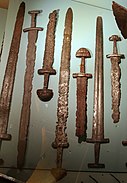
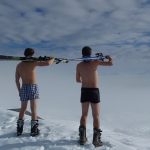
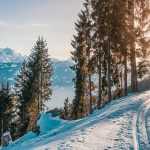

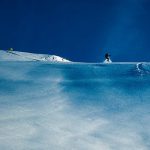
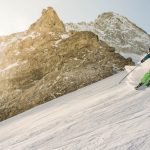
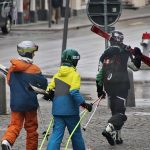

Commentaires
Laisser un commentaire